Food Education: 食育 ( Villaggio’s School Culture II)
Eating is the most basic life activity for human beings. John Dewey, who greatly influences teachers using the Reggio Emilia Inspired Approach, said, “Education is life itself.” So, at Villaggio dei Bambini, food, meals, and eating rituals are a big part of our curriculum. To eat, what do we need to do first? Where does food come from? How does food grow? How do we harvest the food, prepare the food, eat it “properly” using table manners important in our culture? After we eat, where does the food go…?
We encourage children to explore and discover the whole food cycle in a natural flow each day.
- Routines: Folding Towels
Before we eat, we always wash our hands and wipe with a clean dry towel. Instead of paper towels, we use hand towels. So, every morning, we start with folding clean towels and putting them on the shelf for the day’s use. Self care, team work, following directions, small motor (finger muscle) development, eye-hand coordination, and even creativity is observed. (and, those are the skills that local schools’ and international schools’ interviewers are looking for!) It is an important routine to start our day too.
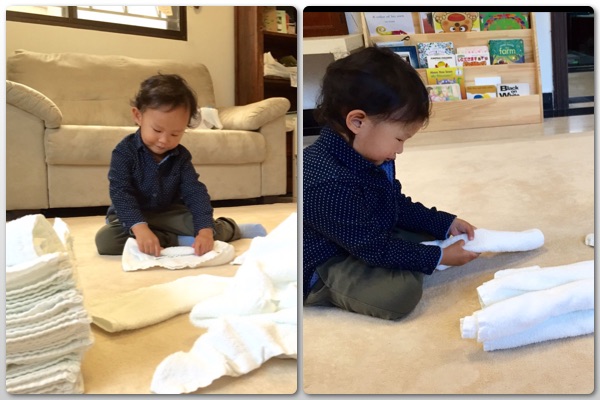
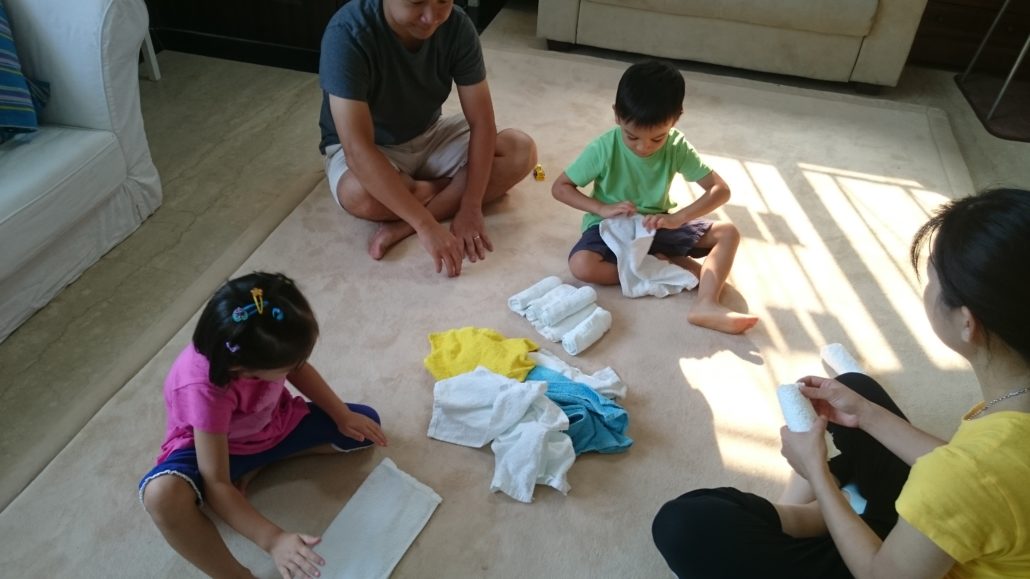
Daddy, mommy, auntie, grandpa, grandma, and teachers all work together! When we work together, we can finish much faster!!! It’s called team work!
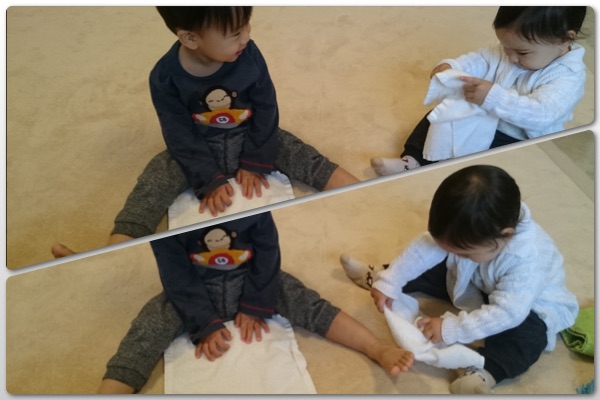
Babies can work together to help too! Imitation is the human’s most basic way to learn. It’s good for young ones, and it’s good for big kids to gain self-esteem as they teach younger siblings what to do.
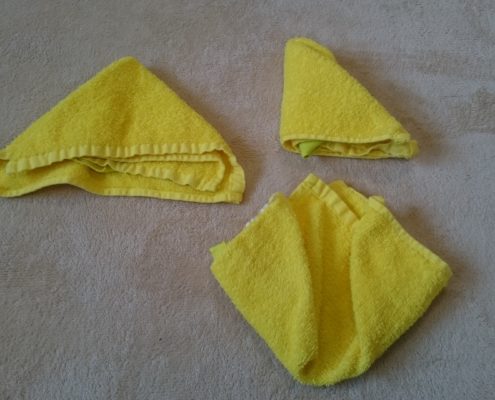
Square becomes different shapes: Geometry
Sometimes, children say there is a better way to fold. And, we keep their ideas. So, when you visit us, you may see weird shapes of towels. But, this is how we support children’s creativity and sense of wonder. It’s a part of everything we do , learning through play and inquiry but working too!
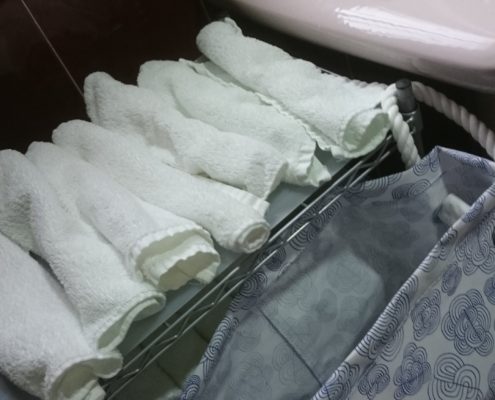
Child: “I made Big Sausage!” : Imagination
- Playing with Soil
We are fortunate to be near local farms in Lam Tsuen. So, we often visit our neighbour farms. Also, we have a lot of nature, so, children know that plants and vegetables grow in the soil. But, knowing about soil and experiencing soil are totally different levels of understandings. So, we have a big open pot of soil for children to play in at all times. It’s a very good sensory stimulation for younger children, especially birth through 24month of age in Piaget’s Sensorymotor Stage. Those sensory experiences really stimulate a baby’s brain development. It’s also good for older children to learn how to use gardening tools, investigate cause and effect (e.g. rain→wet, hot→dry), use imagination, etc.
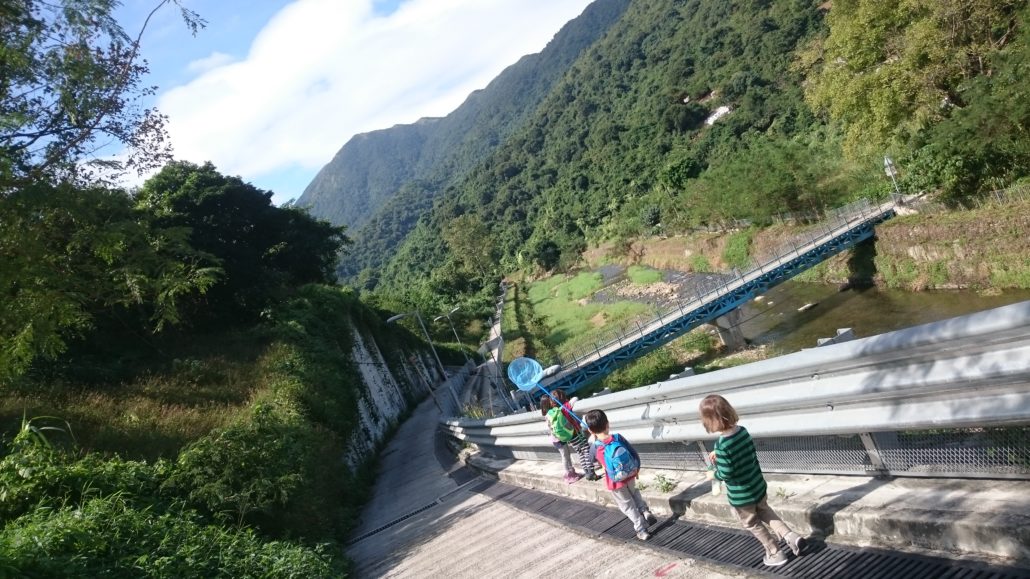
A 10 min walk is all we need to transport ourselves to a world of nature and farmland. This is a very relaxing place.
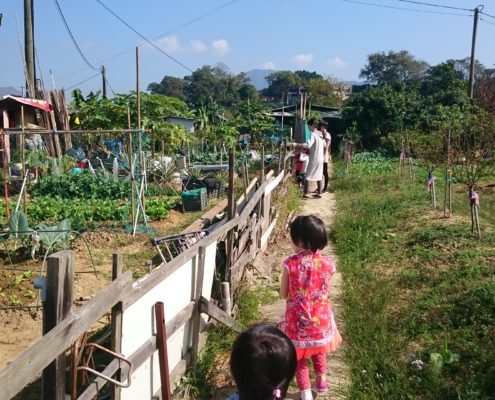
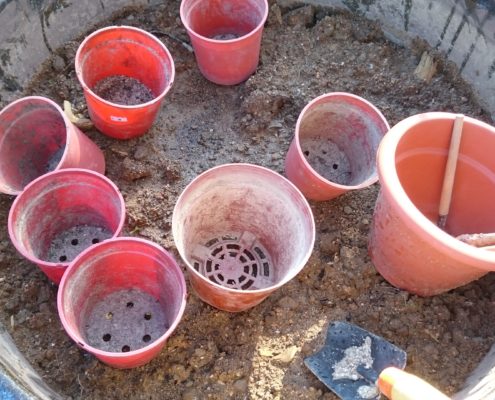
Soil and tools. Keeping play simple allows children’s imagination to grow and develop.
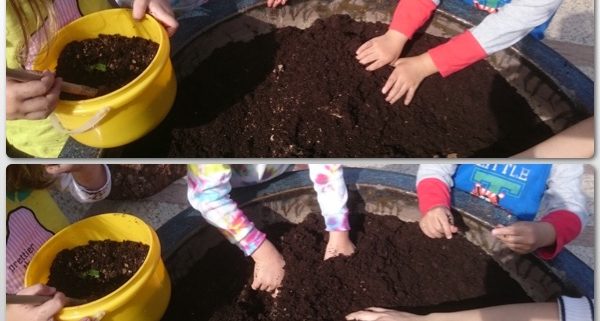
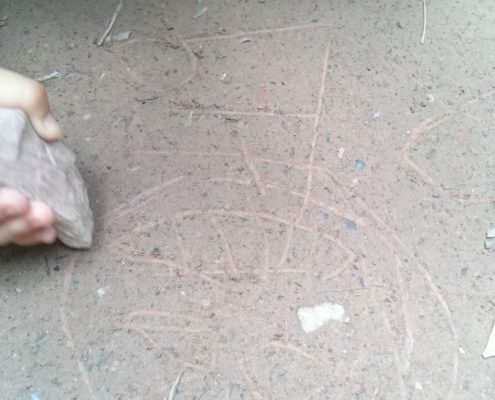
We let them play with rocks and sticks. Is this too dangerous for children? Well, then, I wonder how humans could survive in the wild before we became “civilised.” Yet, we could survive, right? Those are the first tools in our history. It’s the root of our civilisation, and something to celebrate.
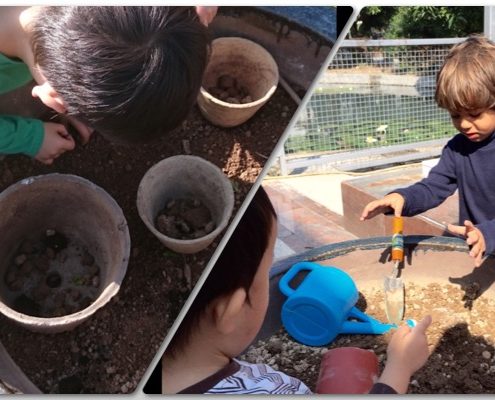
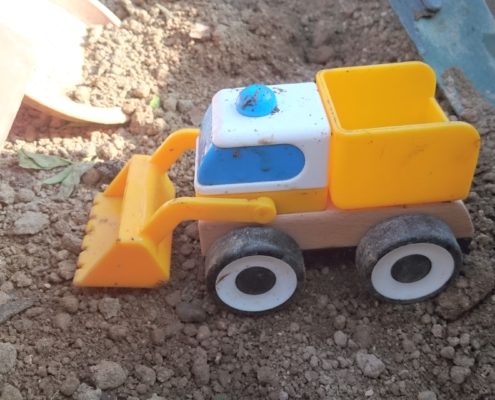
This digger truck works very hard. We see a lot of hard working machines around us. We reflect this in our choice of toys for the children to play with.
- Planting and Care-taking
We plant seeds or seedlings and show children how to take care of them. We water a lot of times like the boy in the book, “The Carrot Seed.” Growing our own food and taking care of plants, while working together as a team, younger and older children develop self-care while nurturing living things. This encourages children to consider the needs of others, which increases their emotional intelligence (EQ).
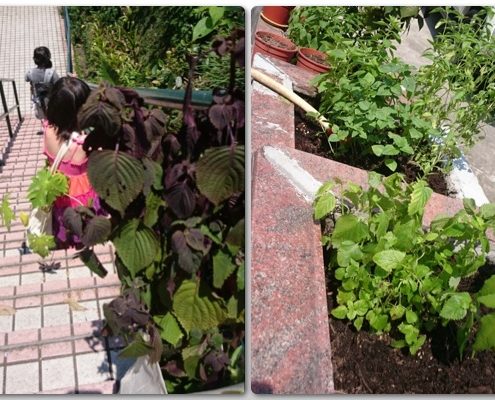
We went our neighbour, Kadoori Farm, to buy seedlings. Their plants are good! And, we are proud to support local businesses too!
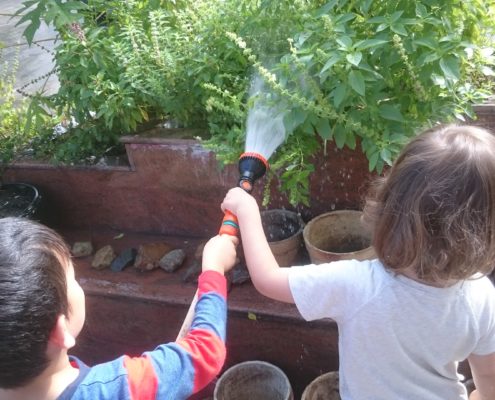
We even water the plants as a team! One child is waiting at the faucet at one end of the hose to listen for calls to “open” & “close”, while the other two are holding the hose together.
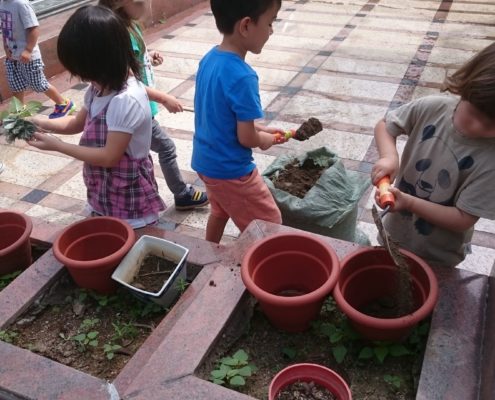
Following 3 steps directions:
1. put rocks on the bottom
2. add dirt
3. add gardening soil.
All children can easily follow directions, if given in an age-appropriate way. The “rule of thumb” is : 2 years old can follow 2 steps, 3 year olds 3 steps, 4 steps for 4 year olds, etc. This is a developmentally appropriate practice. If your child can’t follow a lot of steps, don’t worry, just be realistic with your expectations!
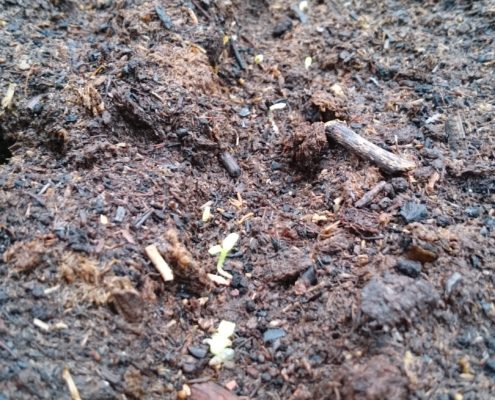
Sprouts from seeds
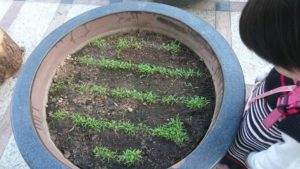
Carrot’s sprouts. Now, when she sees a farm, she can tell which one is the carrot plant! If children are the caregivers, they become more careful with their observations. Thus, children naturally improve their concentration.
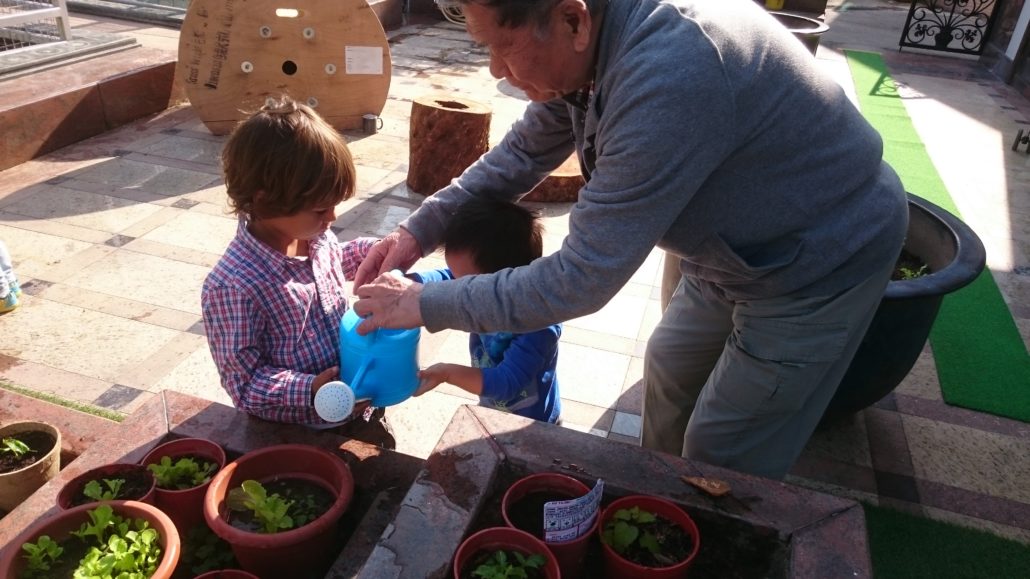
We really appreciate not only parents but also grandparents’ involvement. The ideal setting for children, which we always try to include, is one that is Multi cultural, multi age, and multi generational. (By the way, this grandpa is a great grandpa who is 90 years old!!! We have a great respect for him.)
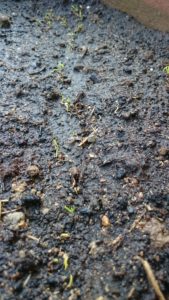
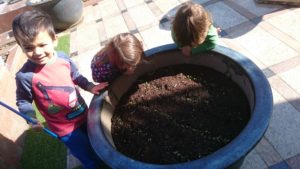
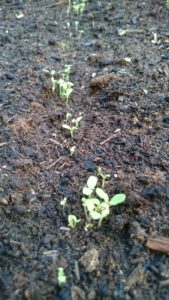
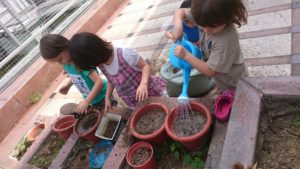
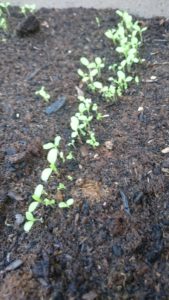
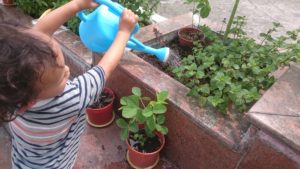
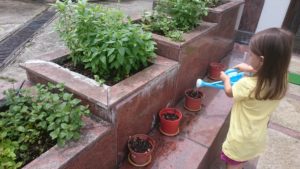
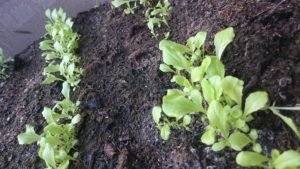
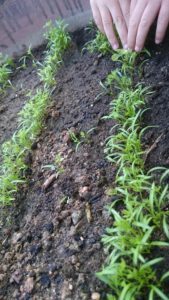
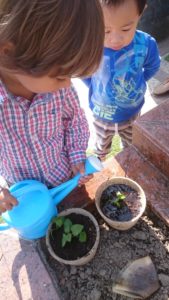
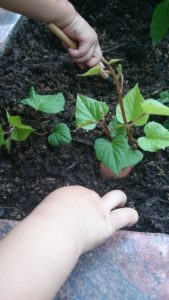
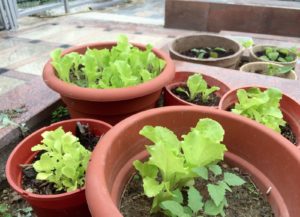
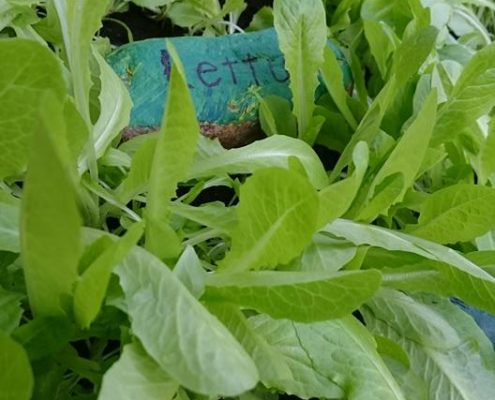
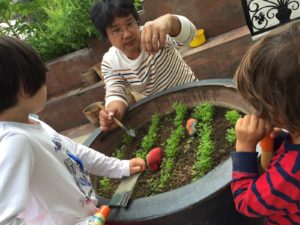
Checking carrots to see if they grew.
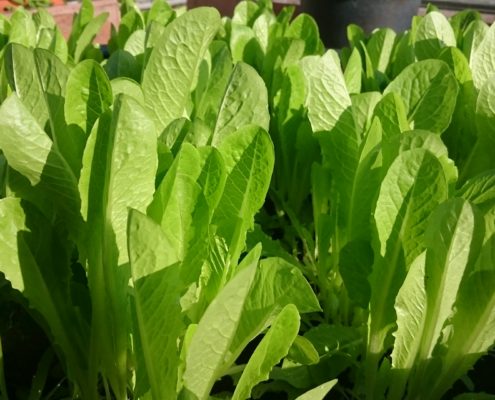
Lettuce is ready to pick!
※ In Hong Kong, it’s hard to feel seasons. But, nature has it’s own rhythms, even if we can’t strongly sense it. In October, we planted tomatoes (summer veggie) and lettuce (winter veggie). While the tomatoes didn’t do well, the lettuce grew well. This is one of our ways to teach seasons.
- Routine: Table Setting
To eat, we need to wash hands, prepare tables & chairs, plates, spoons, water, etc. If we don’t do it, we can’t eat food. Simple, but natural & logical, consequences are our basic discipline technique.
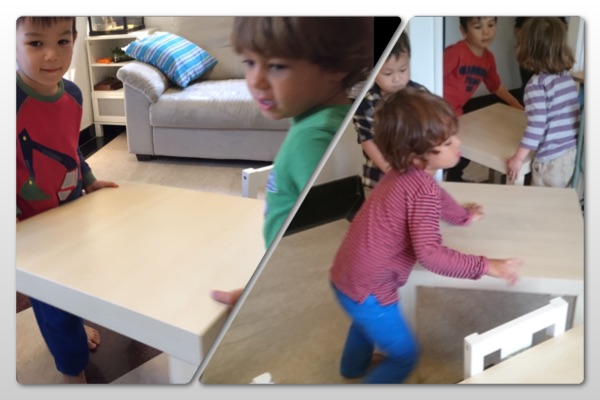
Children set the table by themselves, so the table arrangement is different each day. I hear children say, “Today is ‘7’!” “Today is ‘T’! It’s my name!!!” etc.
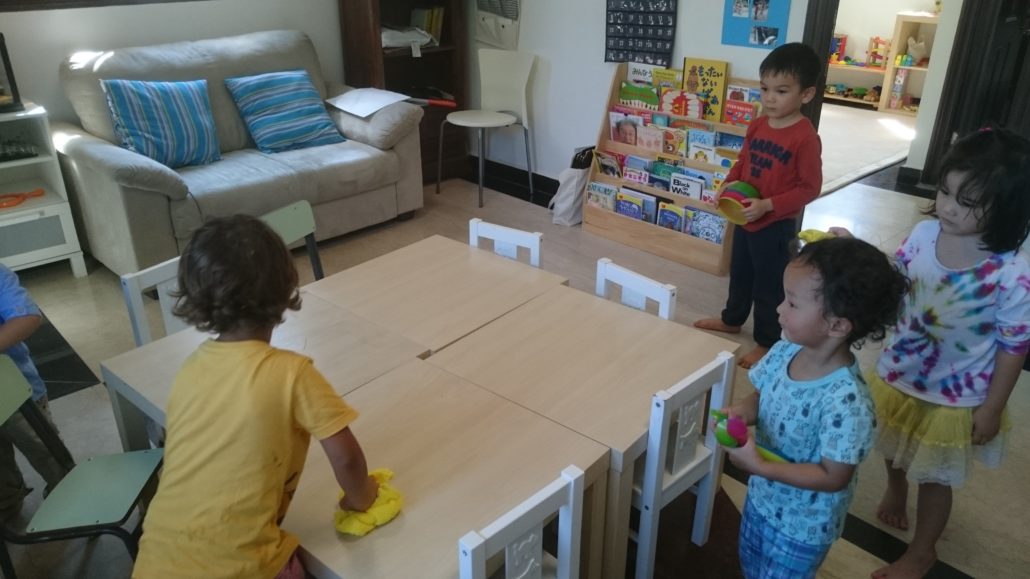
This day was square.
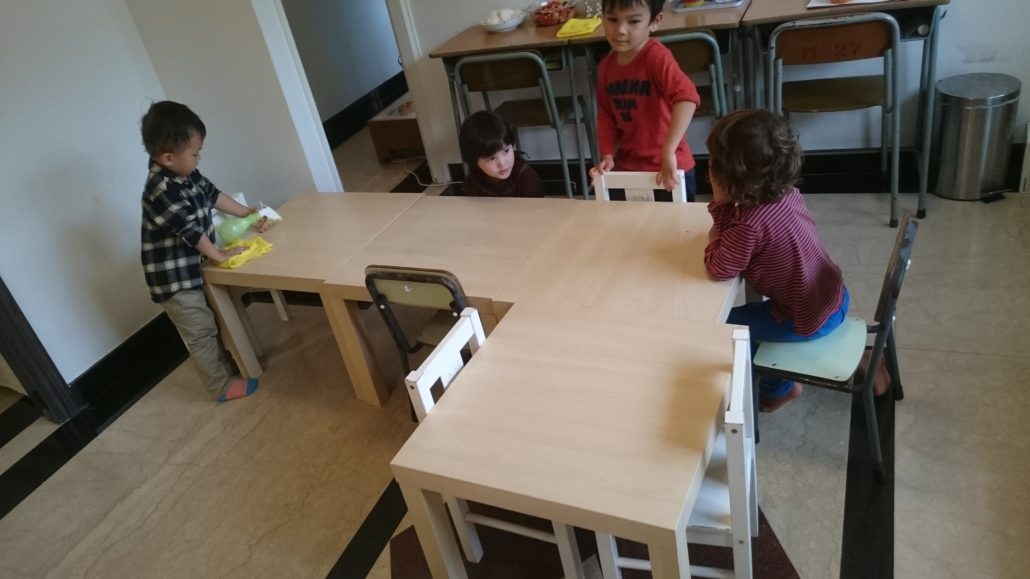
“Number 7” Well, it’s opposite, I know that, but mirroring letters are very good sign for understanding their literacy developmental stage. So, it’s not “wrong.” It’s “right” for their age.
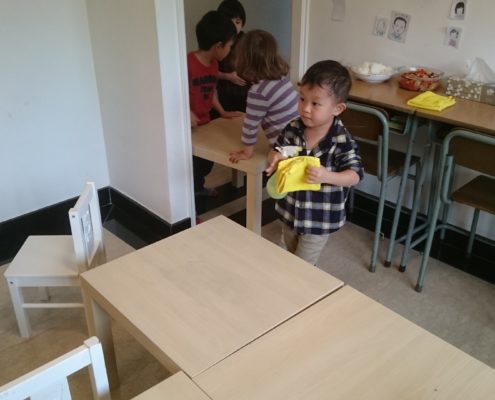
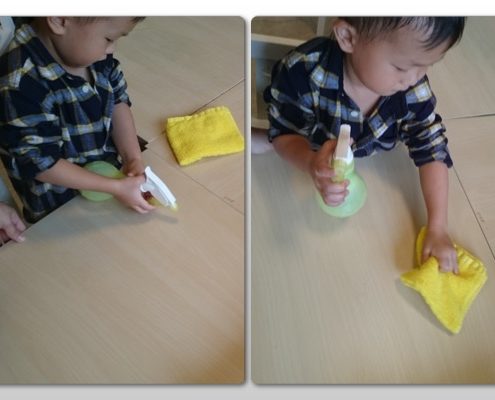
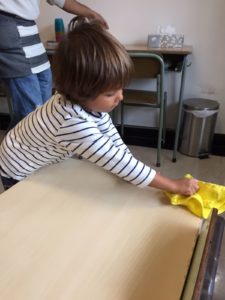
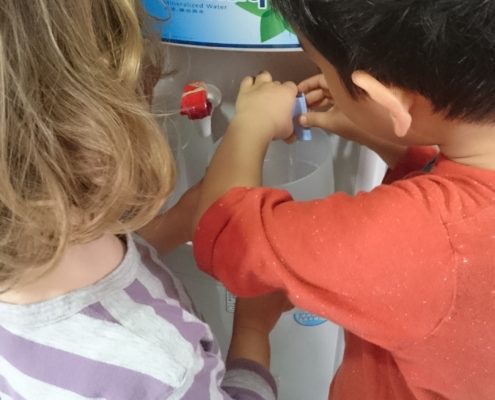
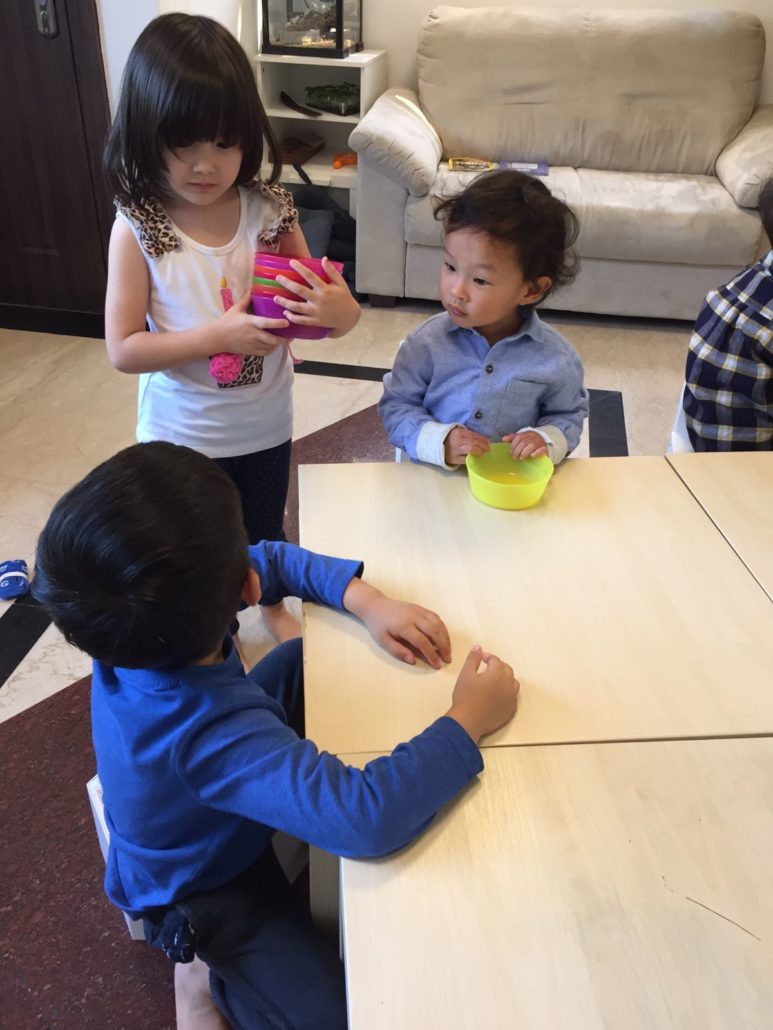
Older Child A: “Did you wash your hands???”
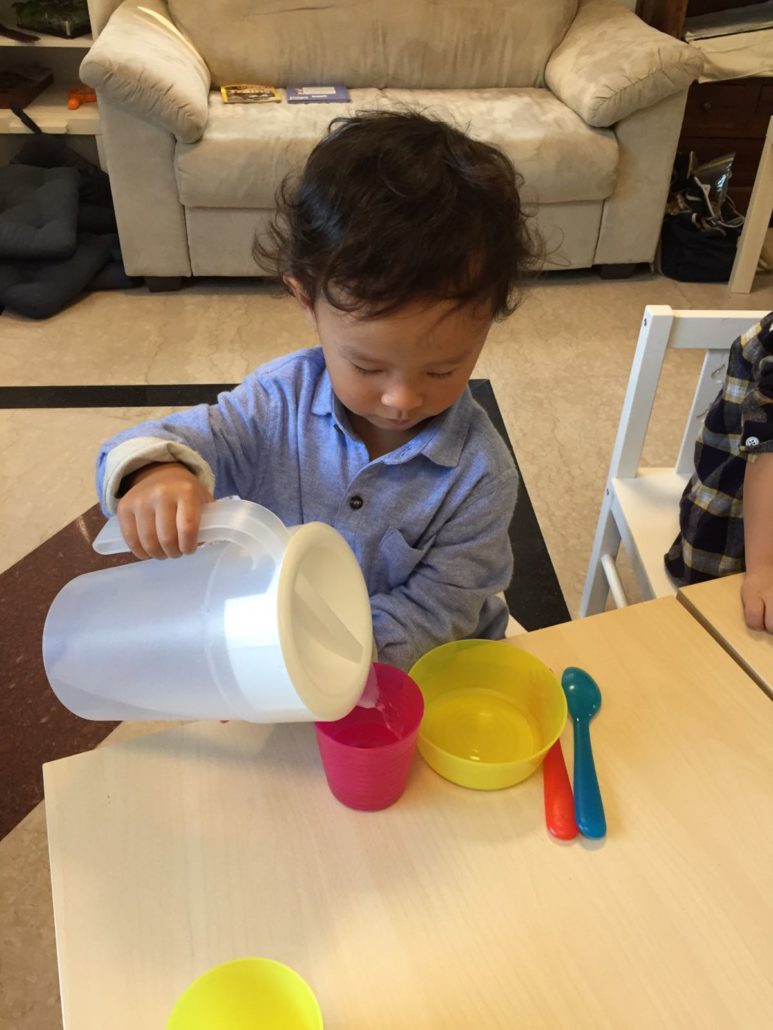
Holding 500g water pitcher and pouring water
He is poring water for his cup by himself very carefully. Indeed, it’s really good table manners, but we are also looking at this activity as literacy (writing) preparation. Sitting nicely at the table, using small motor, eye-hand coordination and wrist control. It’s all the skills children need for writing letters.
- Cooking
Monday through Thursday, we serve lunch for children. At the PTA meeting, we agreed that Monday is parent’s day, so parents prepare or come to school for cooking & sharing their family meal. Tuesday through Thursday, our staff prepare the lunch. We encourage children to help our cooking. Also, cooking is a closed-ending activity, so it’s a good practice for children to follow the directions.
Preparing Vegetable
Using tools and children’s careful work. Here again, literacy preparation, and in addition, concentration and self-esteem, “I DID IT!” are expected to observe. If you see a child accomplished something, please give a high five for the child and enjoy this moment!
Also, you can imagine how happy they eat the lunch that they “cooked.”
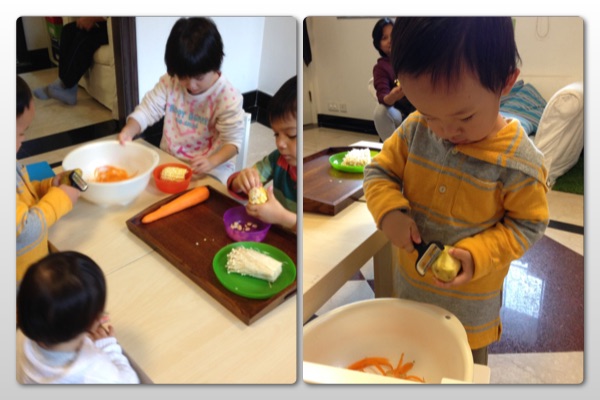
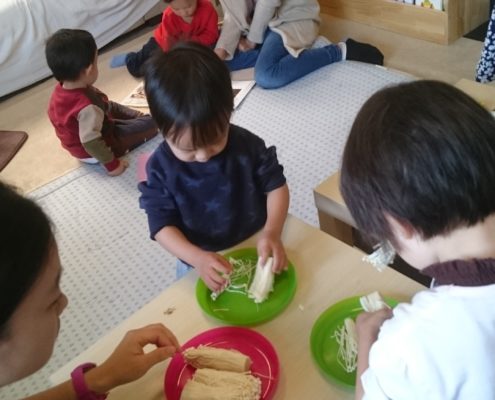
Preparing Rice
We are in Hong Kong, so we often times eat rice. Also, we try to balance bread, noodle including pasta, corn, potato, etc for the staple foods to reflect our cultural diversity. Other dishes are considered with nutritional balance.
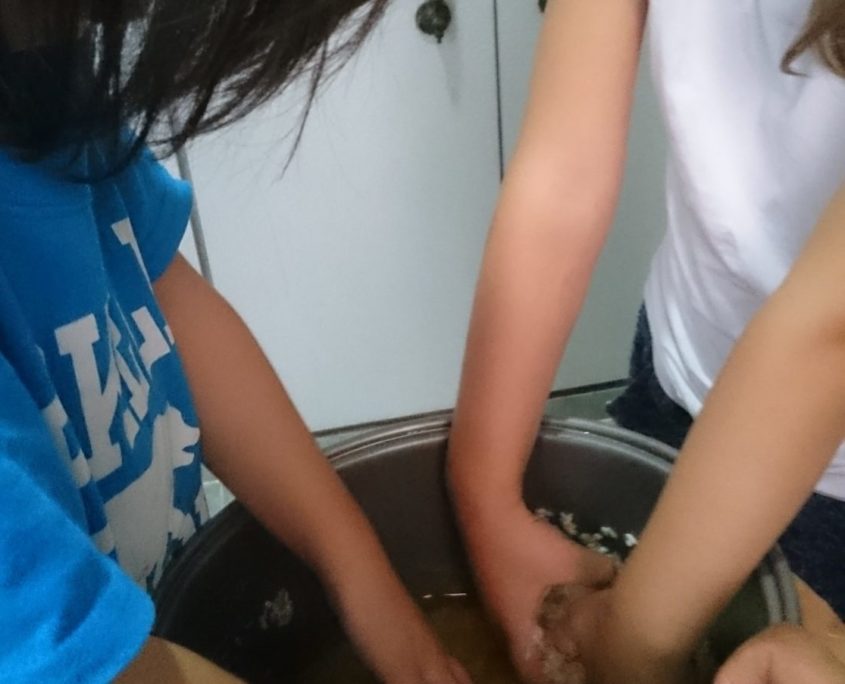
Washing rice. Teacher: “Do we use soap to wash the rice?” Children: “Noooo!” I’m glad they didn’t say “Yes!” At home, children are watching how parents work. Young children’s learning doesn’t happen only in the classroom. This whole world is their classroom.
Making Bread
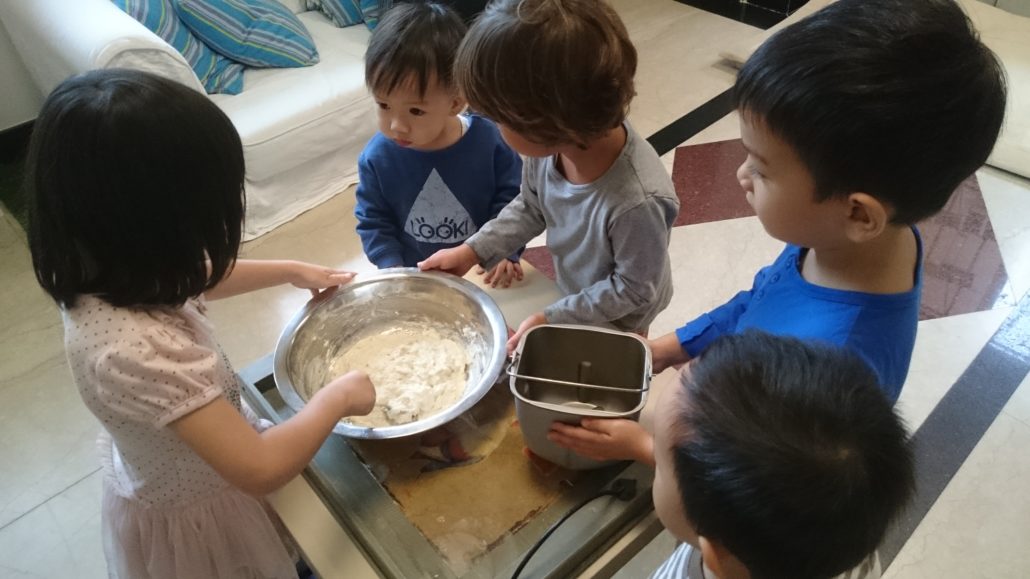
Making bread: Using measuring cups and spoons encourage children’s number recognition with strong context because they really love to eat our fresh bread!
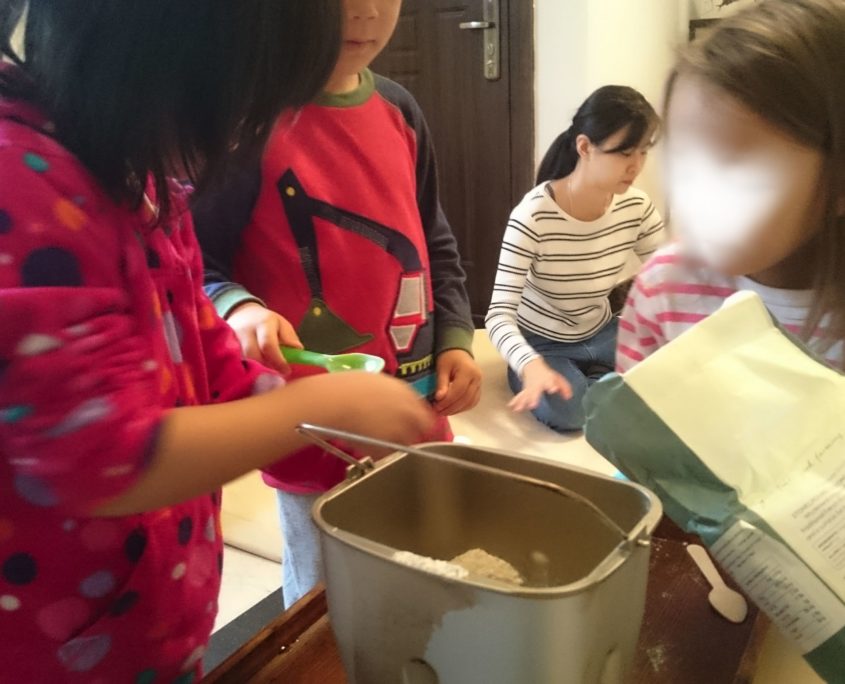
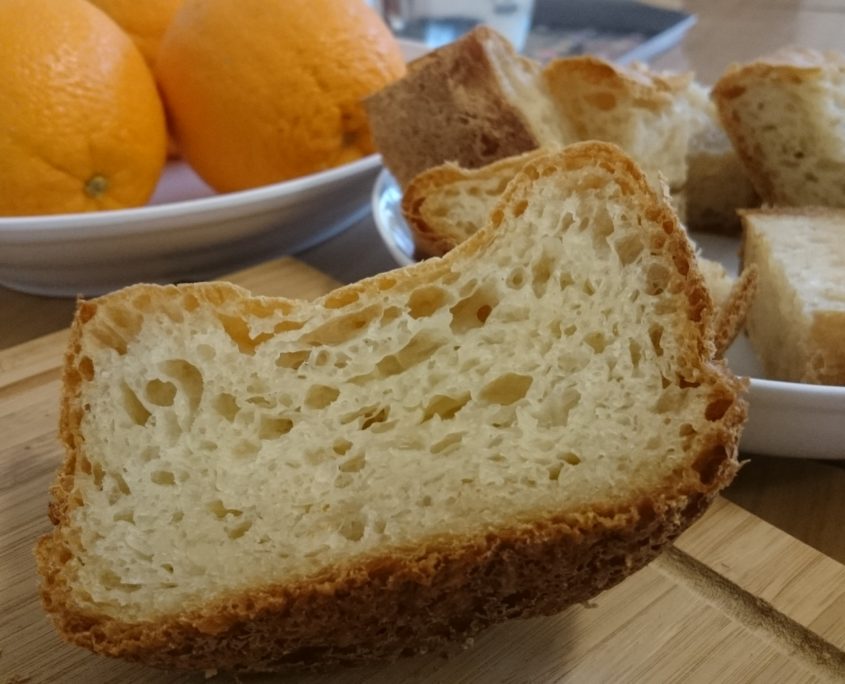
Yummy!
Making Dumplings
This is a collaboration with parents’ support. I wrote more about parent’s involvement below.
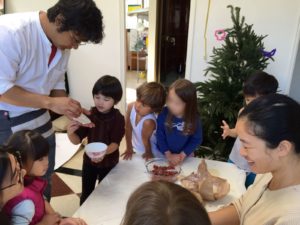
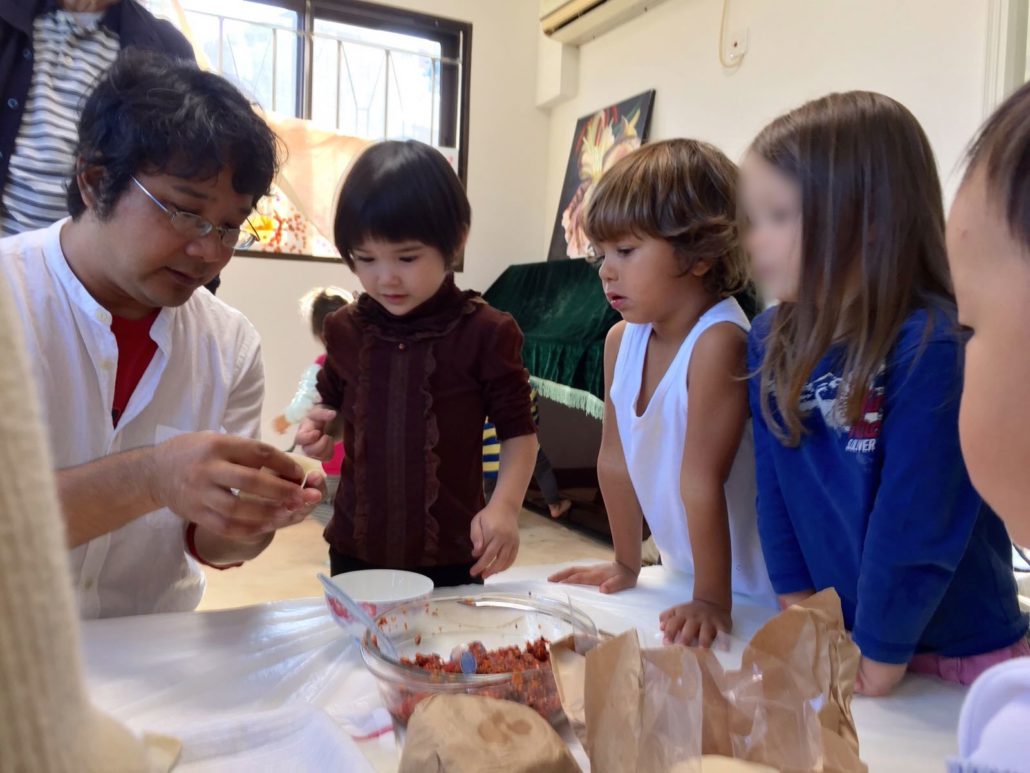
Wrapping dumplings
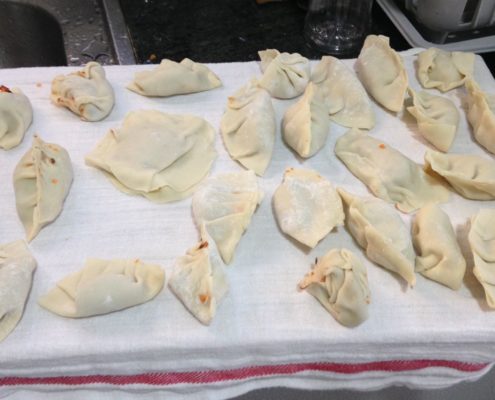
Making Birthday Cake
This is also a collaboration with parents. Parents are partners. We really appreciate parents’ involvement.

- Parents Involvement
One of the Reggio’s principles: We believe that we, all the school staff, and parents are partners for educating our children. So, we deeply appreciate parents’ support for our food education!
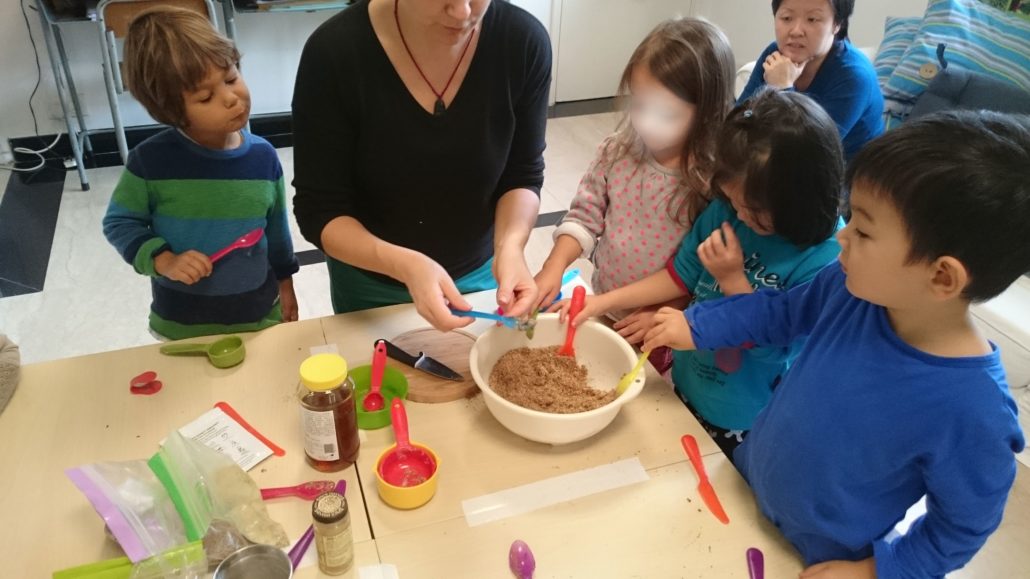
A Czech mom helping children to make healthy snack.
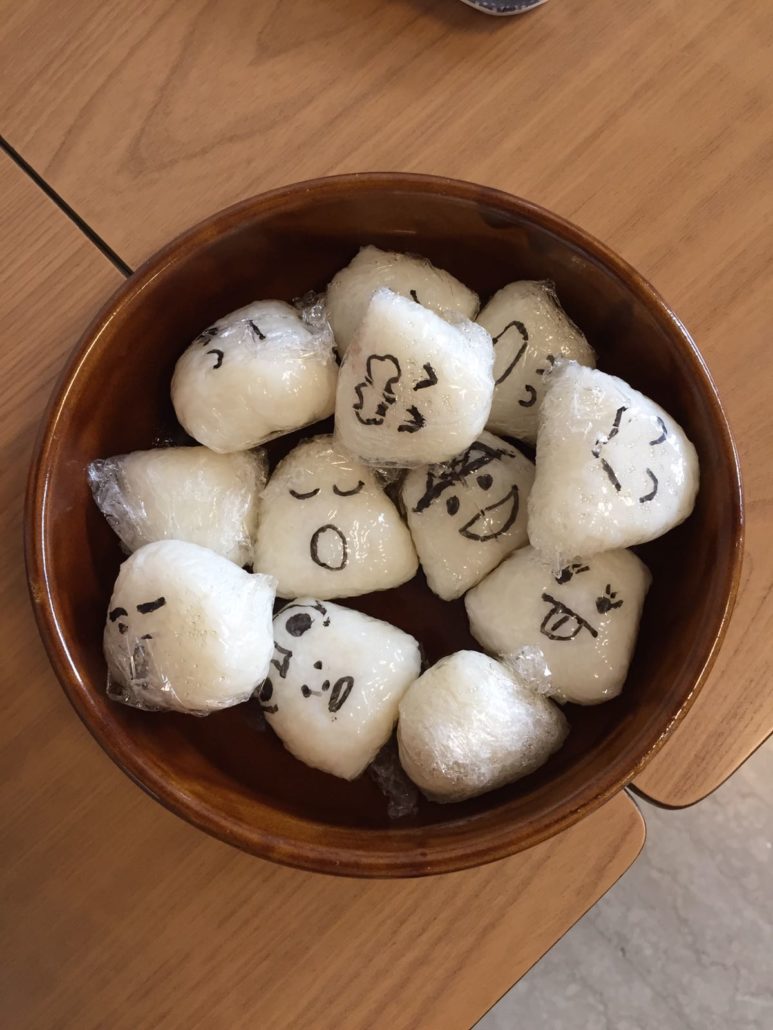
A Japanese mom made those cute おにぎり:Japanese Rice Balls. Children love to eat those foods!
- Eating
We all enjoy eating foods!!!
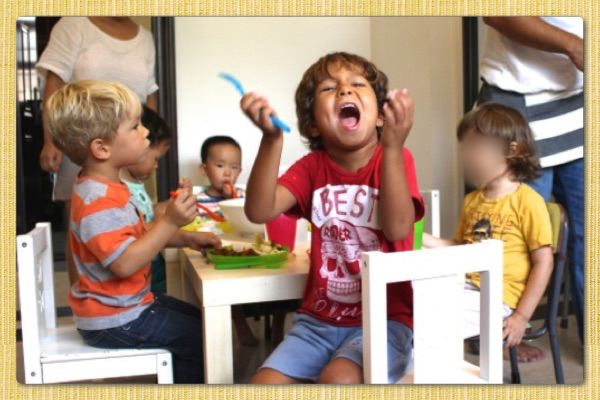
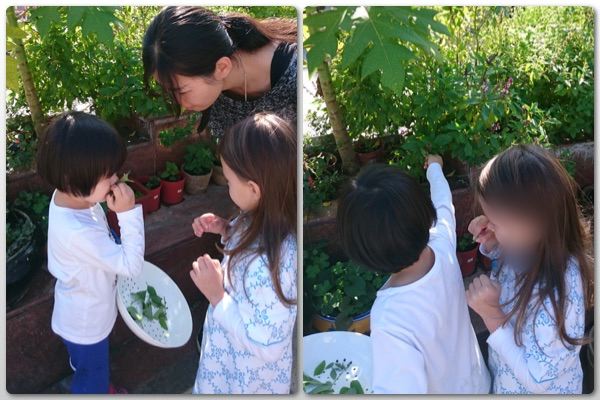
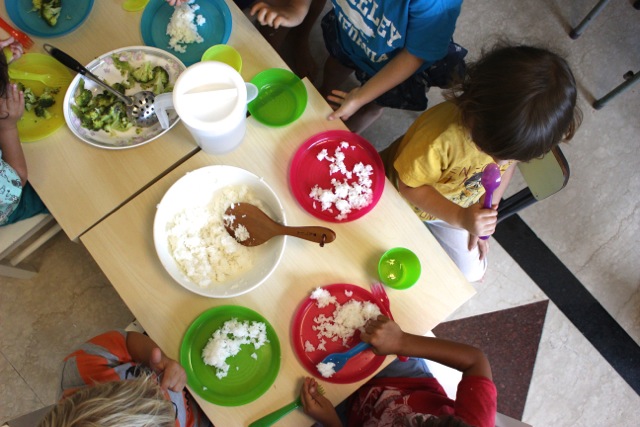
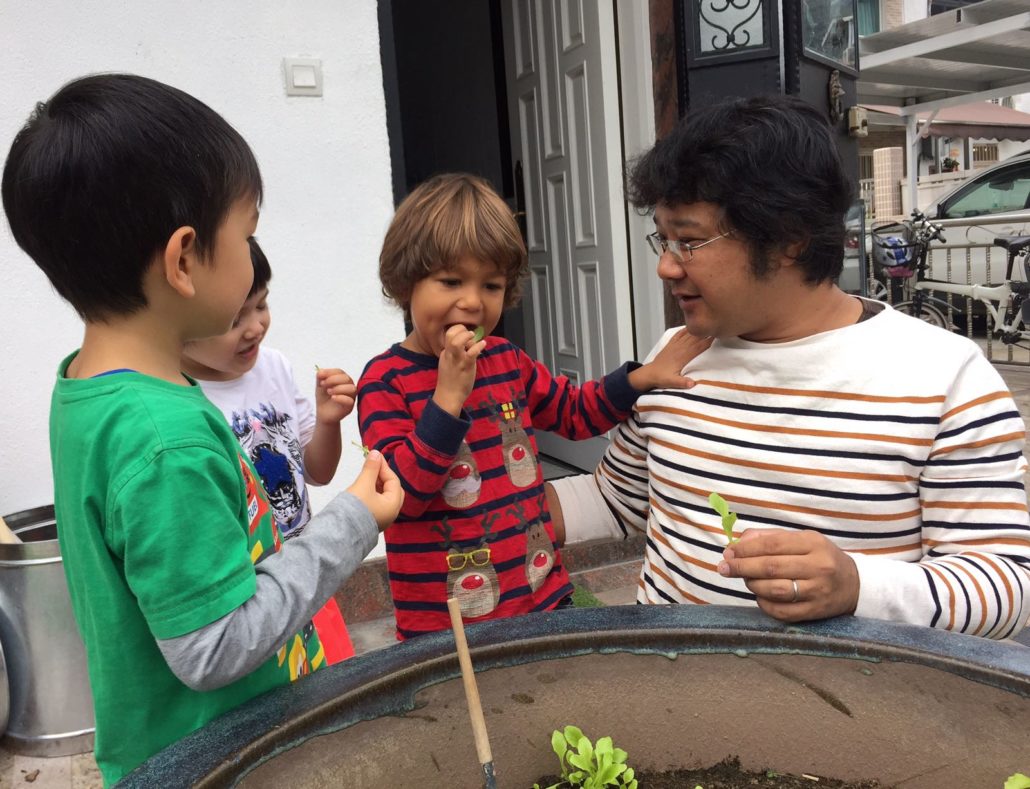
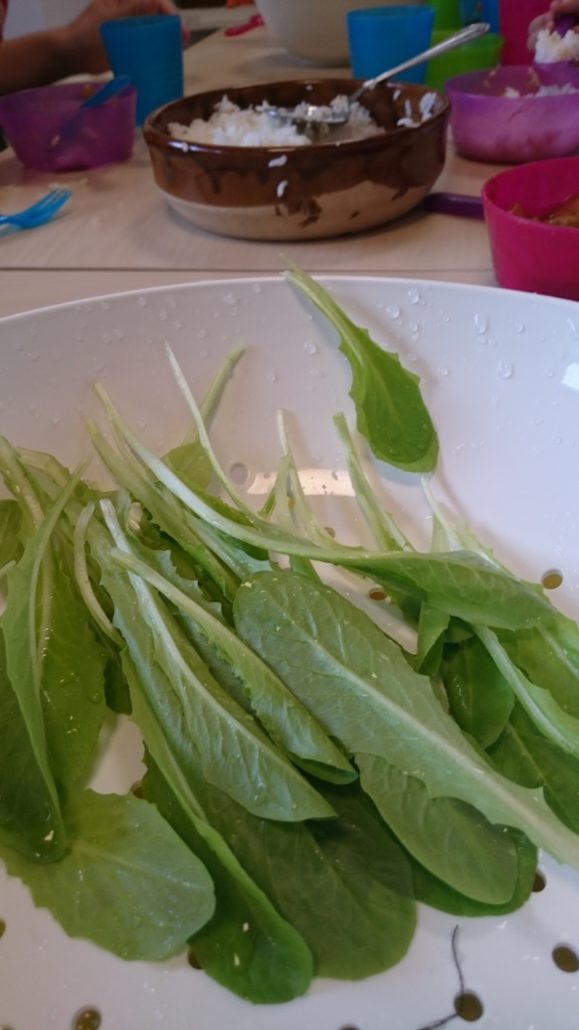
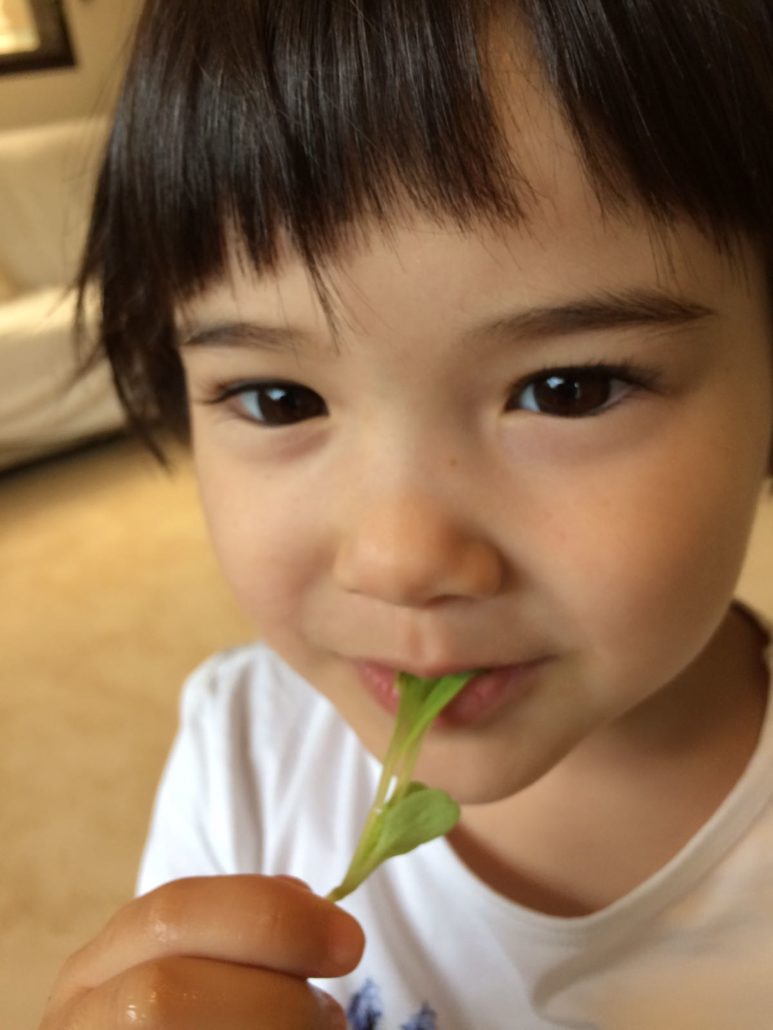
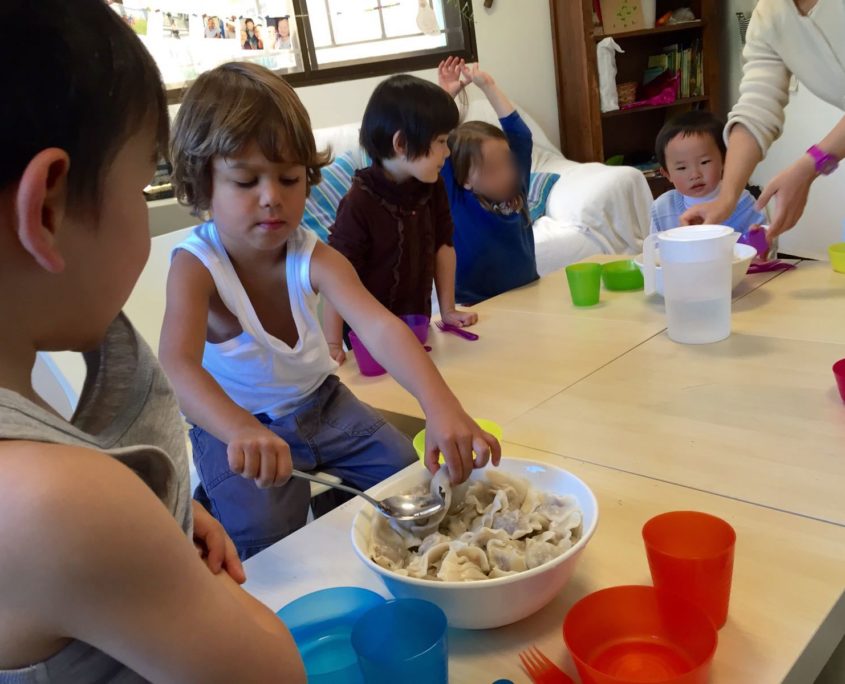
- Community Involvement
This Lam Tsuen community is the place where our children are spending time to grow. Young children learn best from what they see, hear, touch, smell and taste at this moment. Children’s learning is much more spontaneous and vivid than classroom setting with desks and chairs. So, we welcome visitors! They are the great enrichment for our social environment.
Our Friend, Farmer Jacob’s Visit
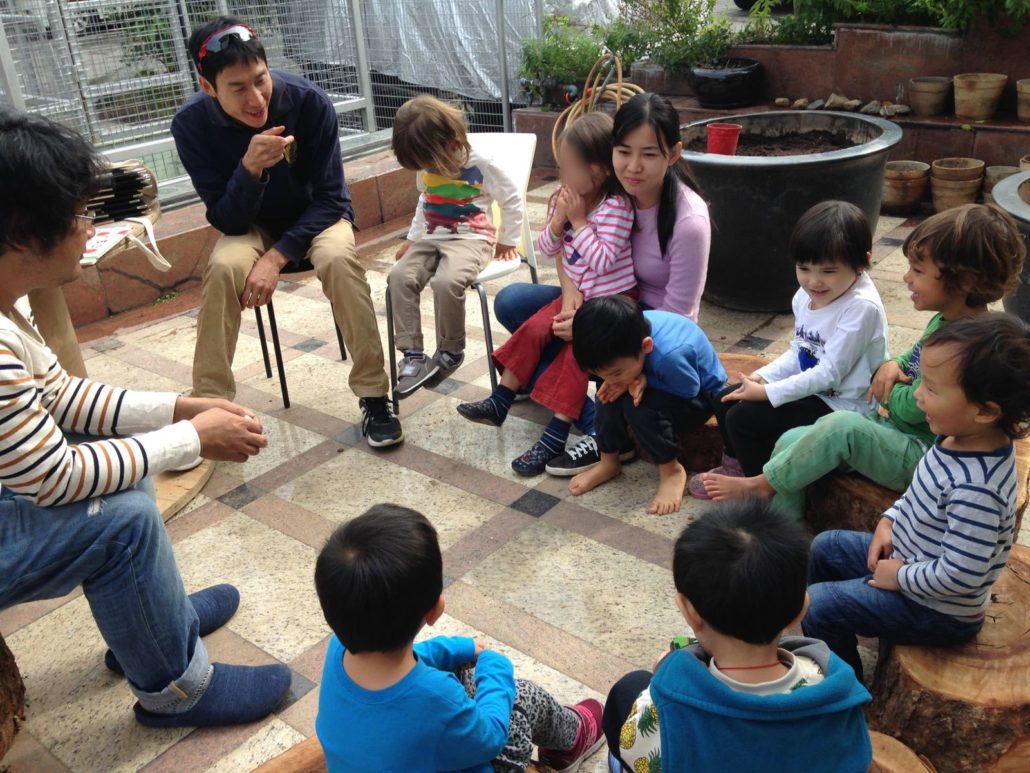
Local farmer Jacob visit us and taught our children how to grow sweet potatoes!
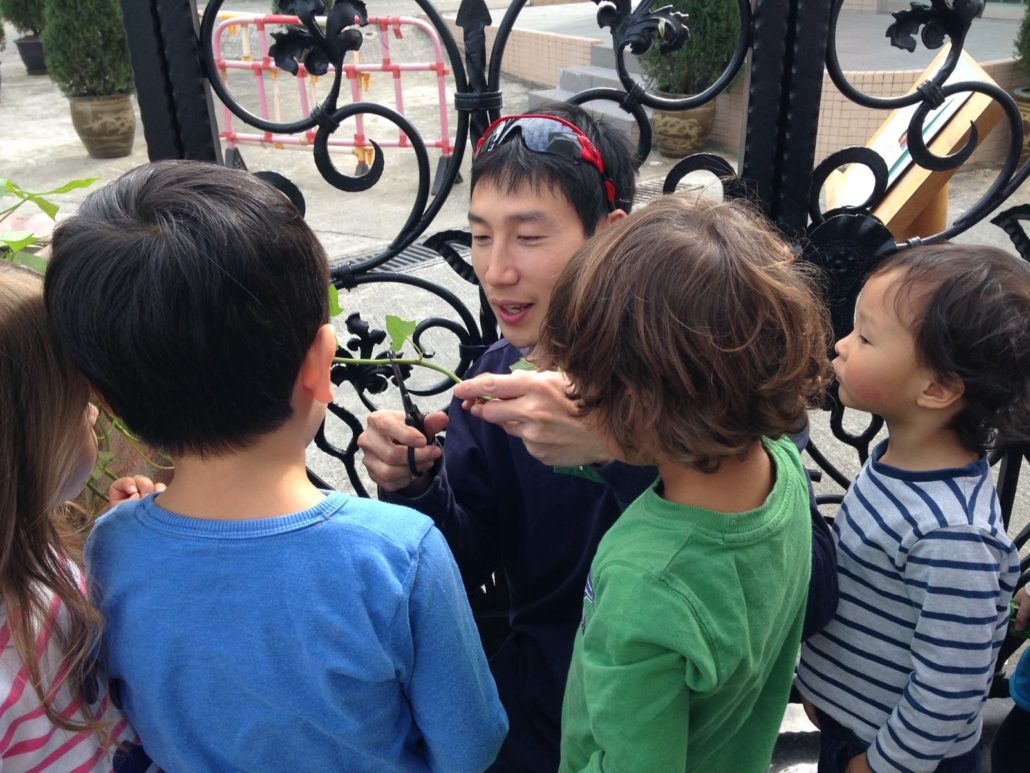
Jacob: “We need to keep five knots, so can you count them?” “1, 2, 3…”
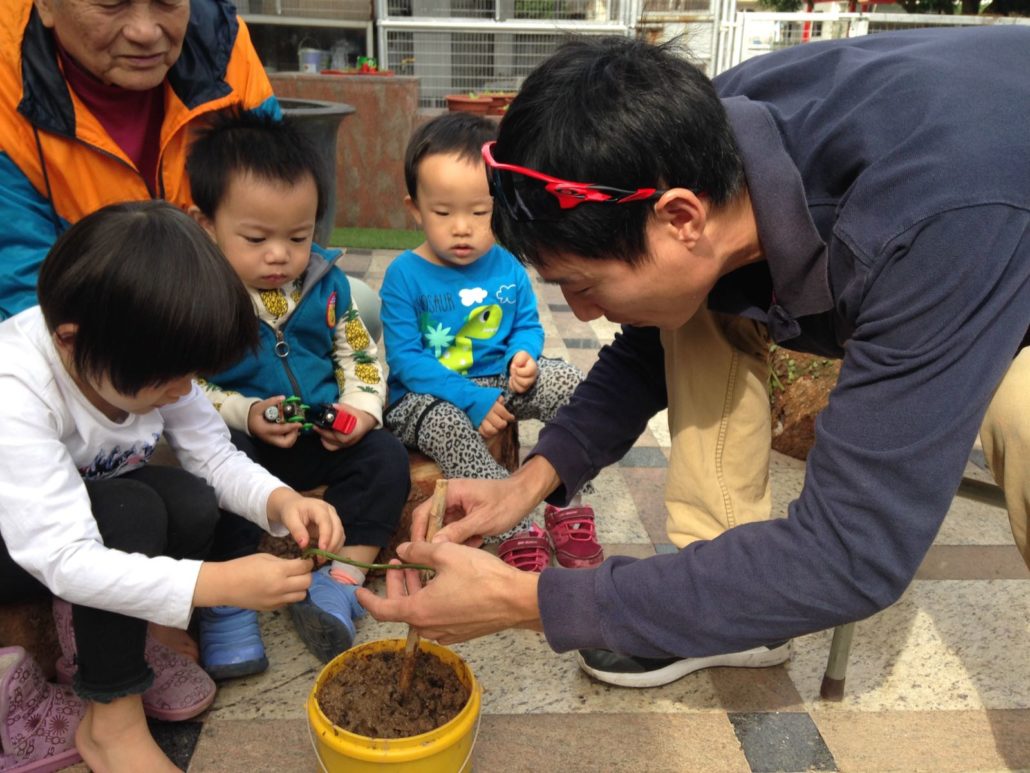
This is a very different depth of learning than reading a book to know how to grow sweet potato.
Thank you Jacob!
Greeting Local Farmers
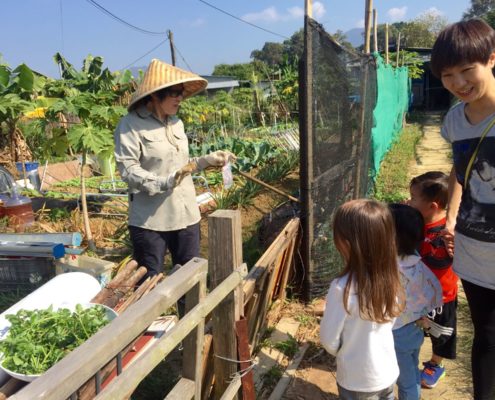
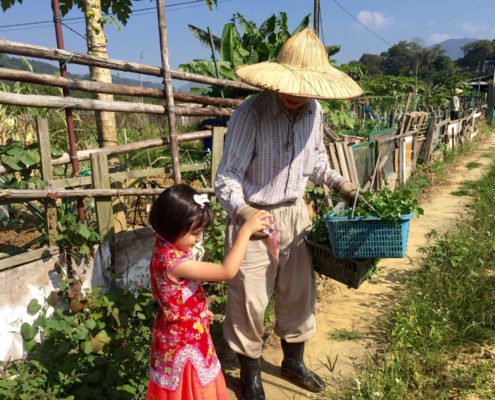
Local farmers who planted watercress in the river and kindly sharing with us. We appreciate their hard work!
Greeting People in Local Restaurants
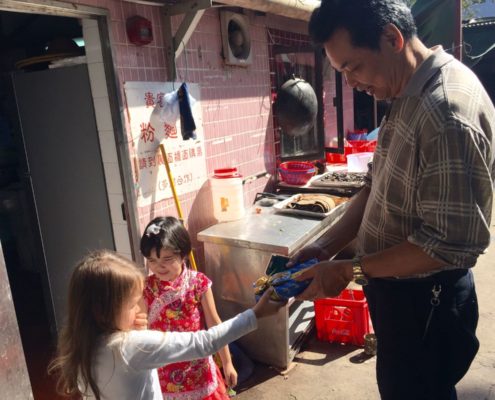
Giving a New Year Gift for the Local Cha Chaan Teng (茶餐廳) owner. Sometimes, we just stop here to drink water♪ They are very kind, and their food is very good too! One of their grandma lives behind Villaggio, so we always say “Hello” to them.
- Introducing Some Activities
Villaggio dei Bambini is Reggio inspired, so we use Emergent Curriculum. Corresponding to what’s going on to the children, we design activities.
Drawing with Direct Observation
The founder of Reggio Emilia Approach, Loris Malaguzzi said, “Every project starts with drawing.” So, we do drawing.
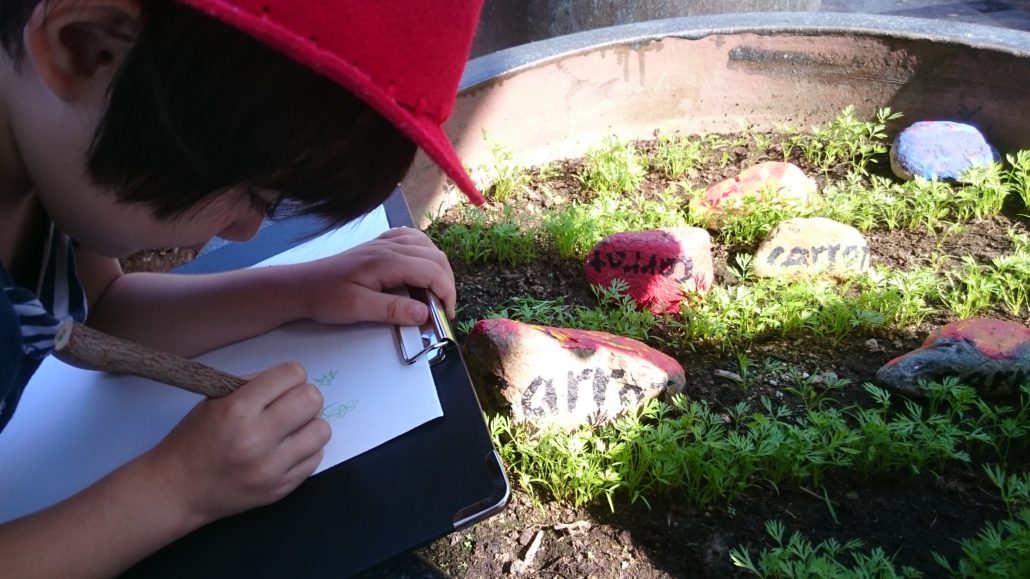
Carrots started growing, so children drawing them.
Observation skill is an important skill for discovery, going deeper question (inquiry), making hypothesis and problem solving. So as divergent thinking. Most of the advanced countries in the world think those skills are very important in early childhood education, but it seems like Hong Kong schools don’t mind about it. Why do the advanced countries think it’s important? If a child didn’t develop those skills, what will happen??? Maybe, it’s time to review what Sir Ken Robinson said.
Sir Ken Robinson : Changing Education Pradigms
Matching Game
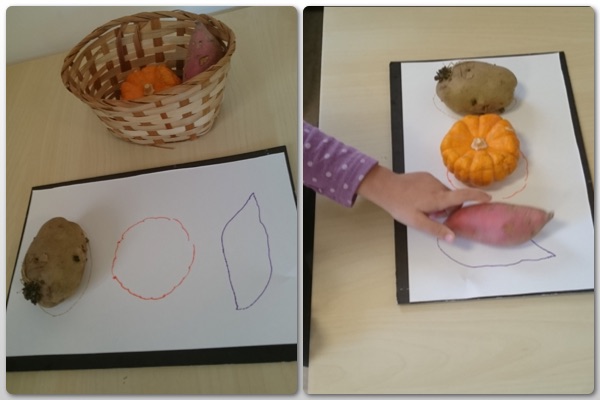
Pumpkin from Halloween season, sweet potato from farmer Jacob and potato from our kitchen. All connecting to children!
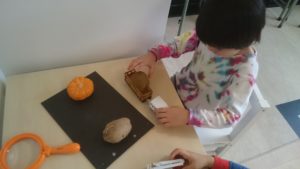
Sometimes, trains help carrying them.
Story Telling ①
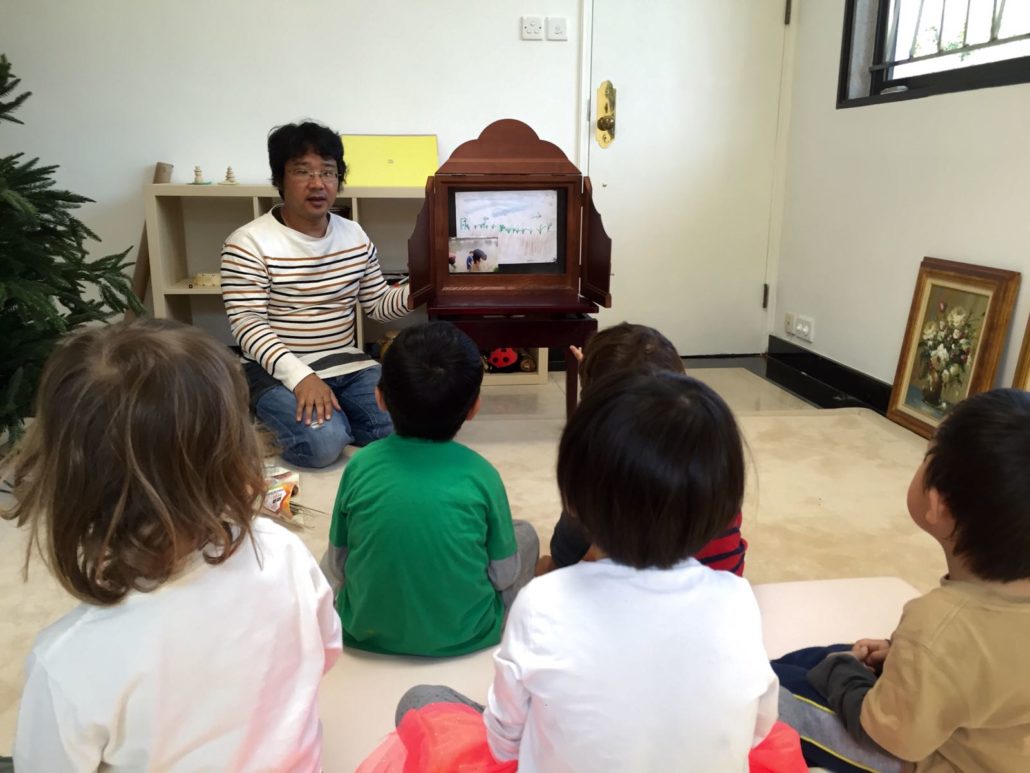
“Rice Story,” was made by Kai Kuwata when he was 5y from his rice growing experience at age 4. When he visits Villaggio, we always ask him to read his story to our children.
Detail of the story: Mabo’s blog
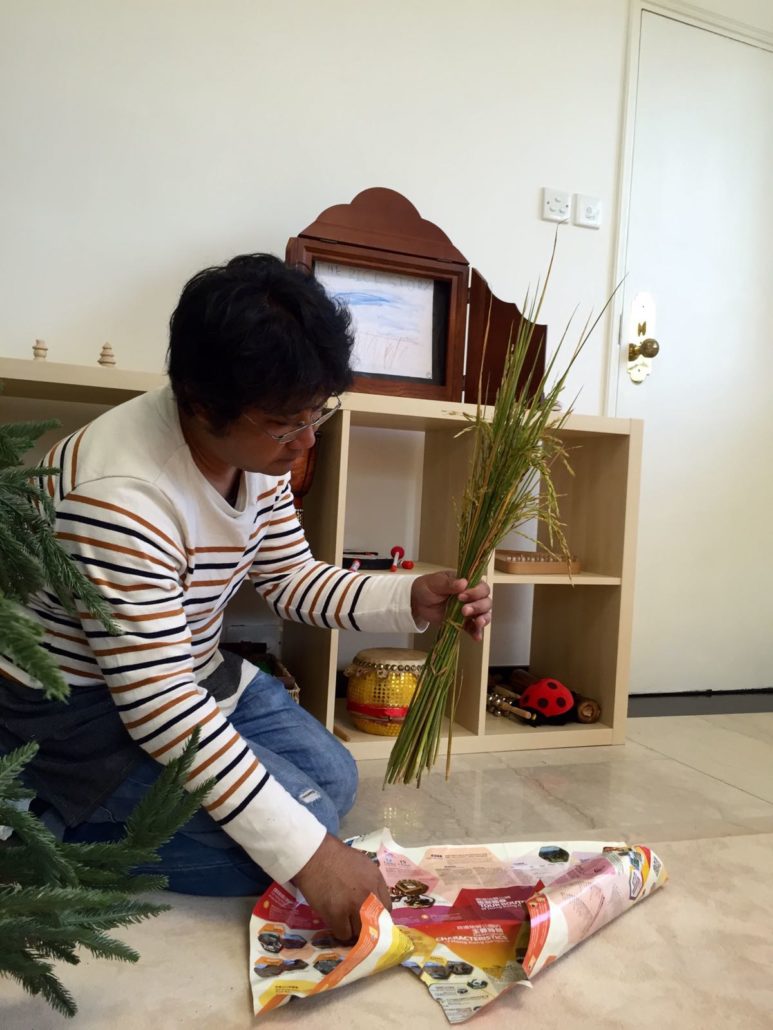
Rice plants from Hong Kong’s real rice field
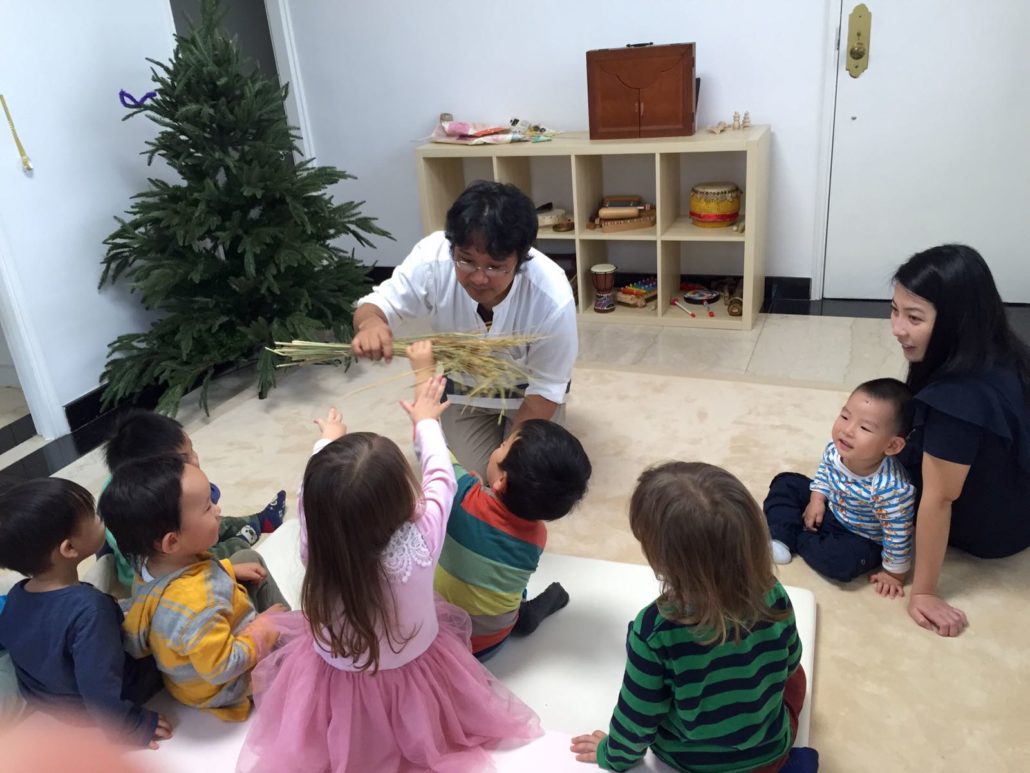
Touching and smelling rice plant. We eat rice a lot, but this is very different experience with rice.
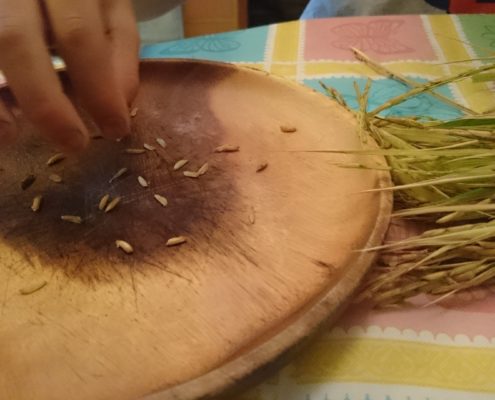
Preparing for next season to grow!
Story Telling ②
As Sigmund Freud mentioned, young children go through the Annal Stage. And, everybody eats, everybody poops. So, pooing is nothing wrong. It’s just an opposite side of eating. It’s nothing to feel shame or guilty. However, we noticed that a lot of Hong Kong children have this shame and guilty for their bowel movement, unfortunately. As Erik Erikson’s psychosocial development shows, those shame and guilty are negative side of development, and they will lead inferiority for age 5y-12y, which is such a sad impact for school age children. Who can succeed with inferiority? And, who can grow up and develop a good healthy identity with inferiority?
Not only we support the fact that pooing is nothing wrong, but also, we tell children that poo is very useful thing for growing vegetable as a fertiliser. So, poo is not a bad thing, it’s a good thing! We would like children to proud of their first product!

We use “みんなうんち (Everybody Poops)” to take children’s shame & guilty away from doing poo poo. It’s nothing wrong. Your mom, dad, everybody does poo poo too.
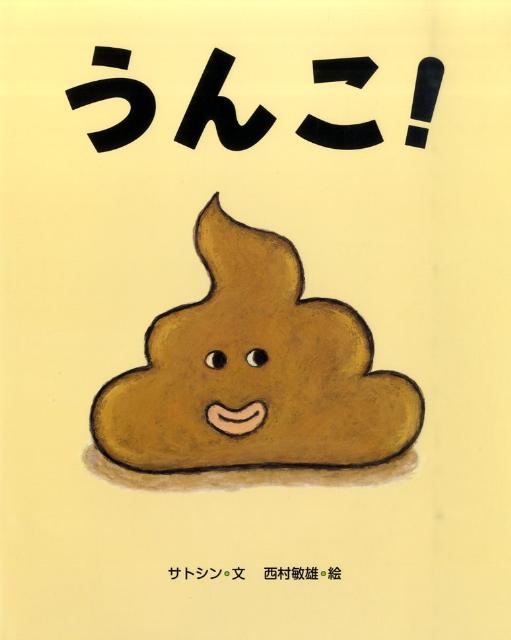
And, we read “うんこ!(Poo!)” for children to feel better that actually poops are useful.
※ In deed, for our plants and vegetable, we use fertiliser from local fruit bat poo poo. So, it’s real. Not only in the story.
Please don’t forget that poops are children’s first products!
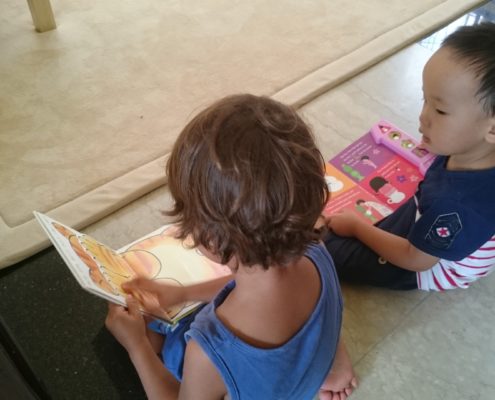
Making Signs for our Vegetables
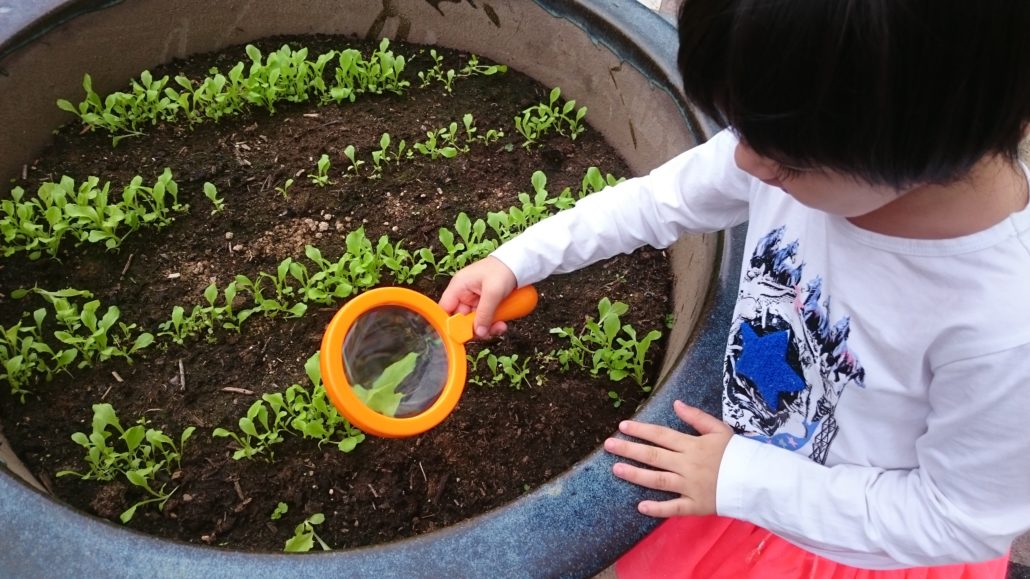
Plants started growing, and people started asking, “What’s this???” So, we needed to make signs for the plants.
- We went river to pick rocks that shapes like lettuce and carrot.
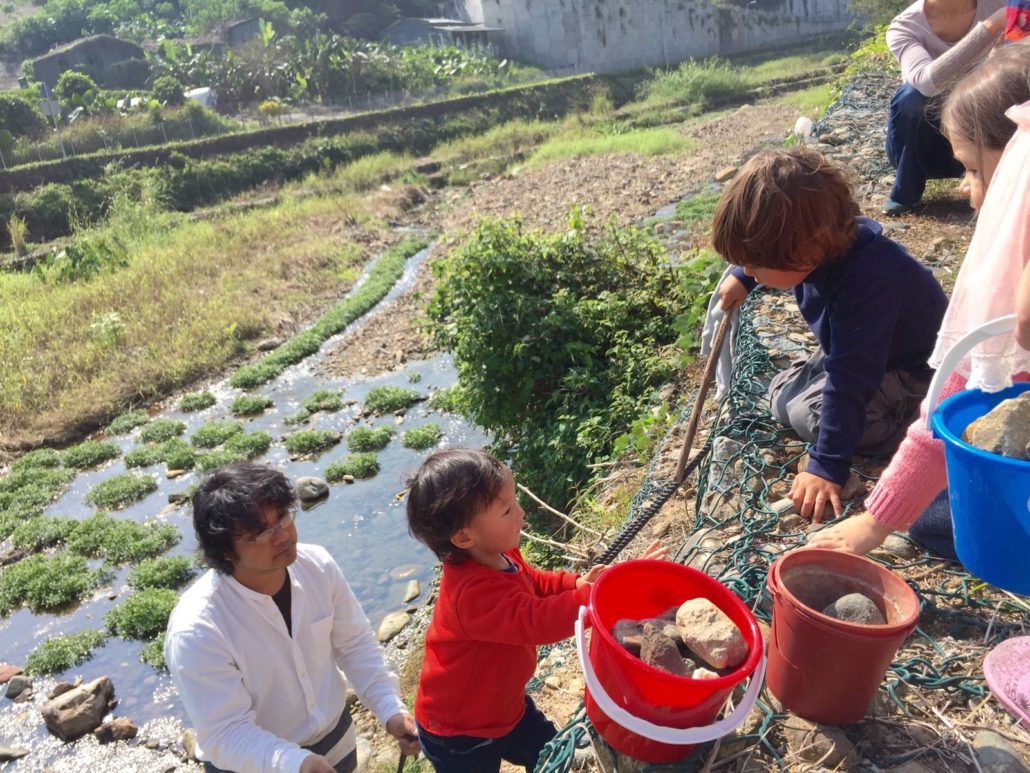
2. We thought about the colours of lettuce & carrots and made the colour from primary colours.
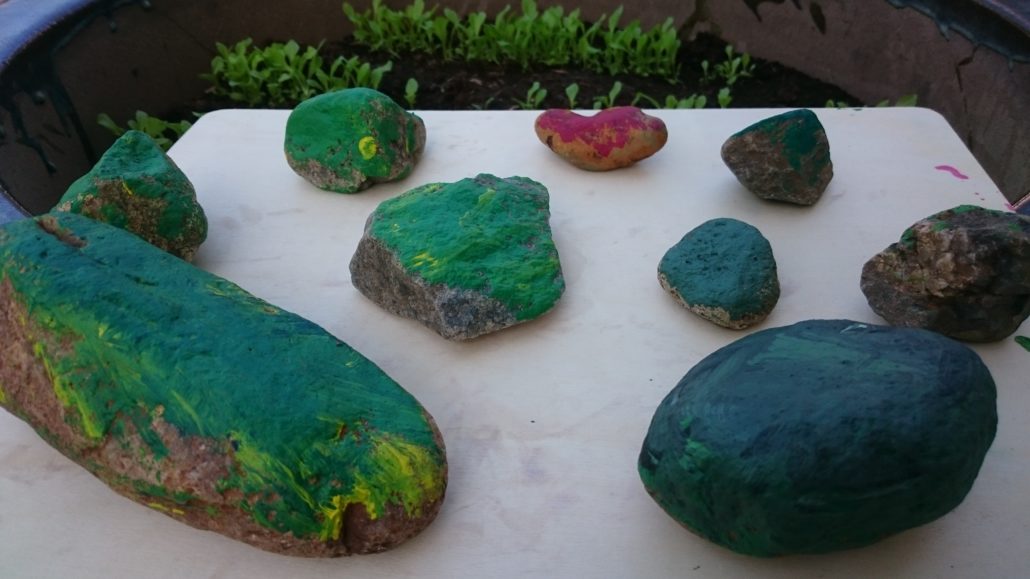
So, each shape is different, and each colour is different. Some are darker, some are more yellow. One is even red for lettuce!! It’s all fine.
3. We set in the pot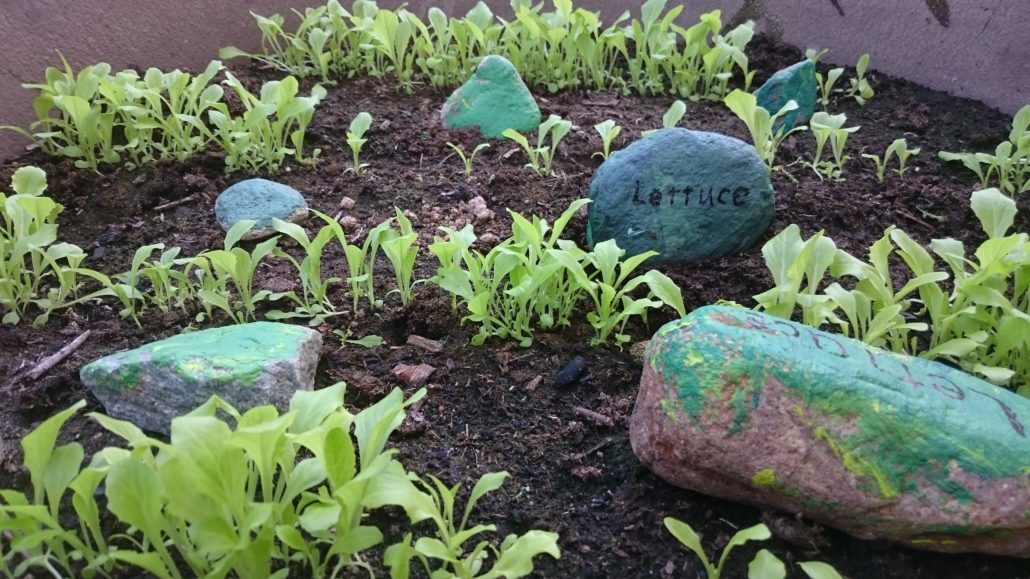
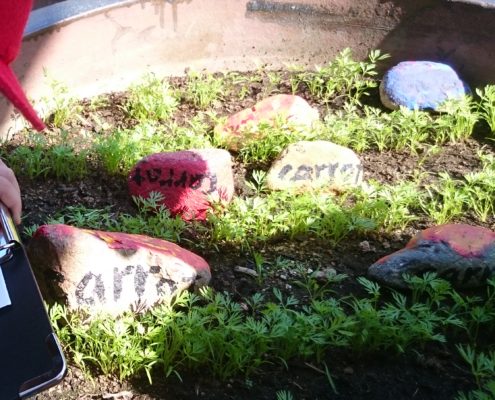
Now, everybody can see what those vegetables are!
Making Vegetable Soup
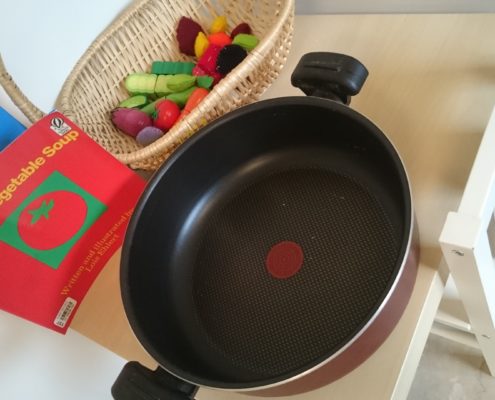
When our lunch menu is “vegetable soup,” we play vegetable soup. This activity was inspired by Angelica, Hoopla Education, Italy! It’s one of the children’s favorite activities!
Exploring Banana Forest
In our classroom, banana is always ready for children to eat. Why? In Hong Kong, we see a lot of banana trees, they are everywhere, and it’s nutritious, good taste and good for encouraging children’s motor skill.
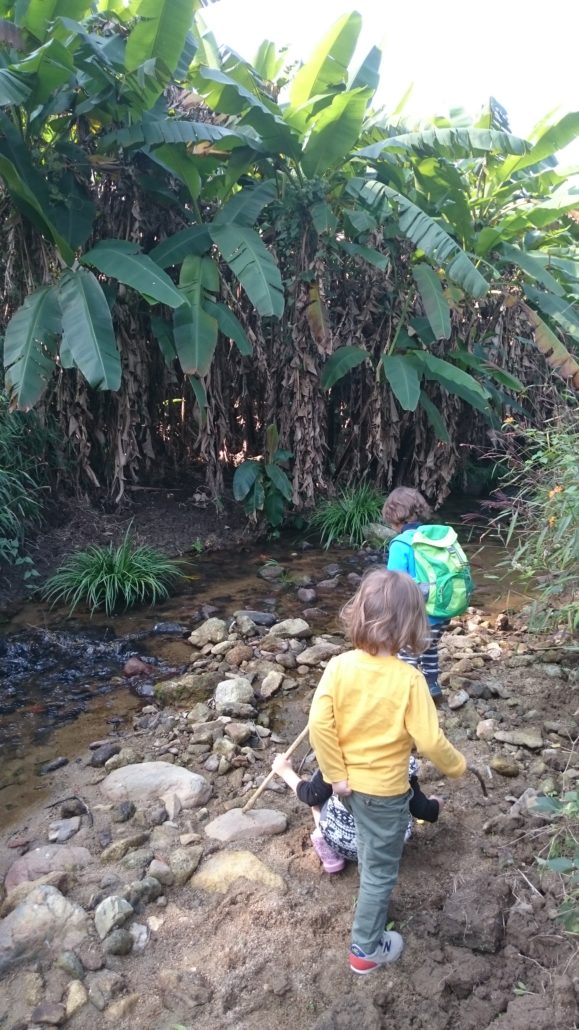
This banana forest is a walking distance from our location too.
Learning about Seasonal Fruits
Nature knows seasons. Strawberry season, we talk about strawberry. Sweet potato season, we talk about sweet potato. Often times, we ask children to guess what’s inside of those fruits look like: Colours, shapes, lines, patterns, smell, taste, seeds etc. Thus, we try to stimulate children’s curiosity and hypothesis making.
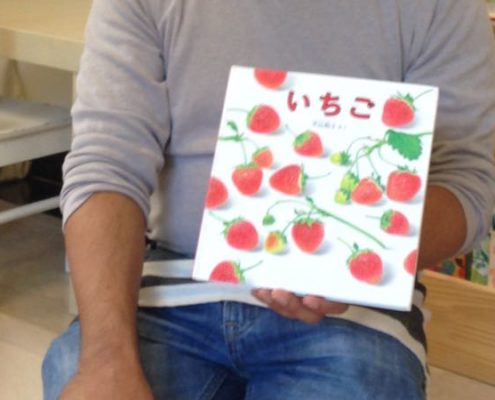
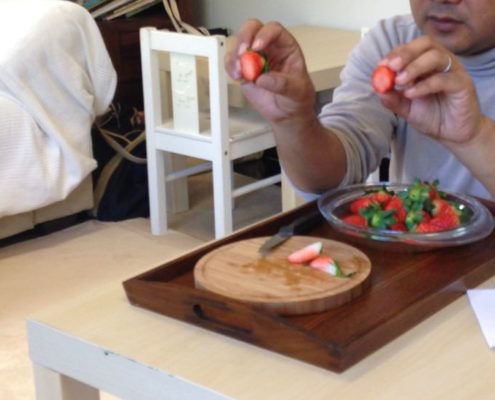
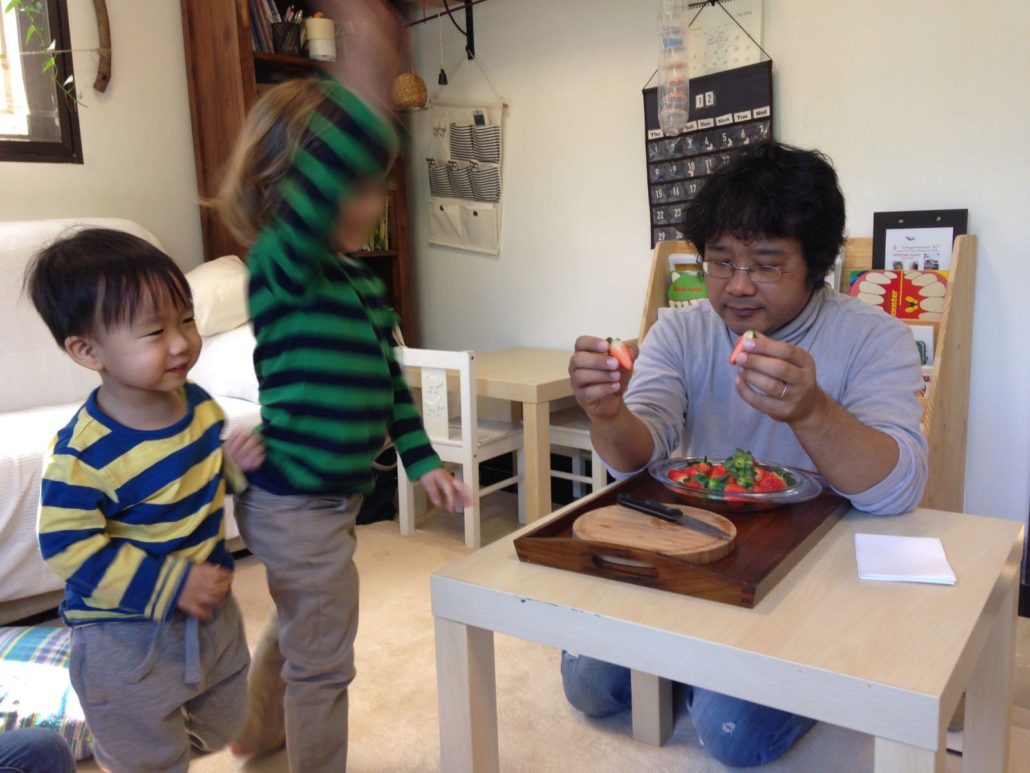
- Additional Photos
Here is some photos that we observed that related to food education.
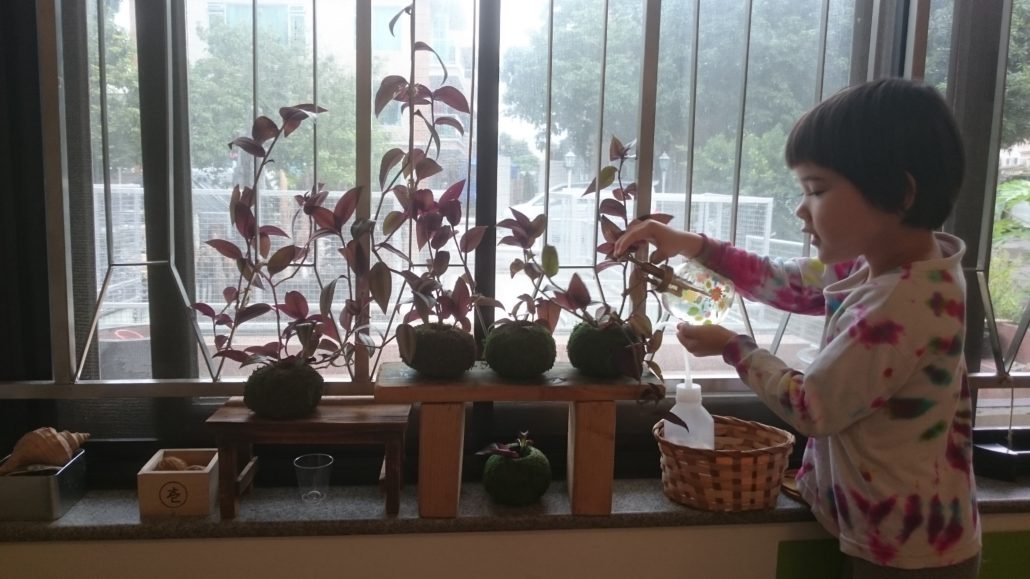
Without asking, they are taking care of our plants.
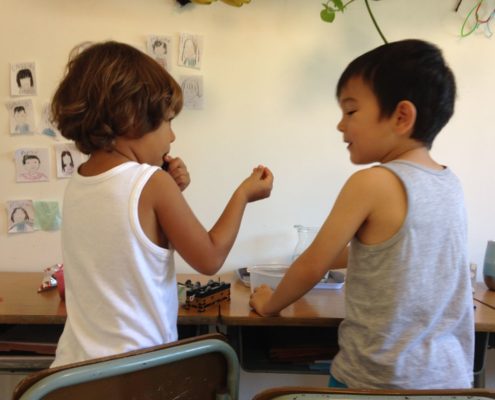
They share their own snack to their friends.
Children enjoy the beauty of flowers from our plants

Sweet potato flower
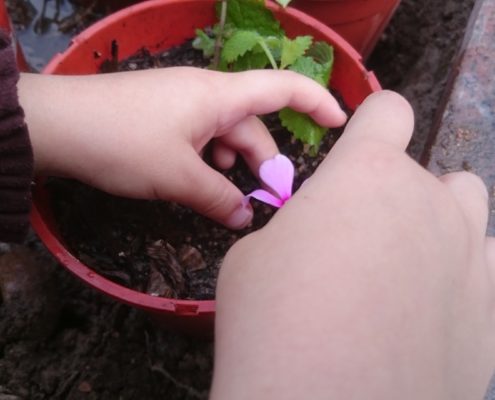
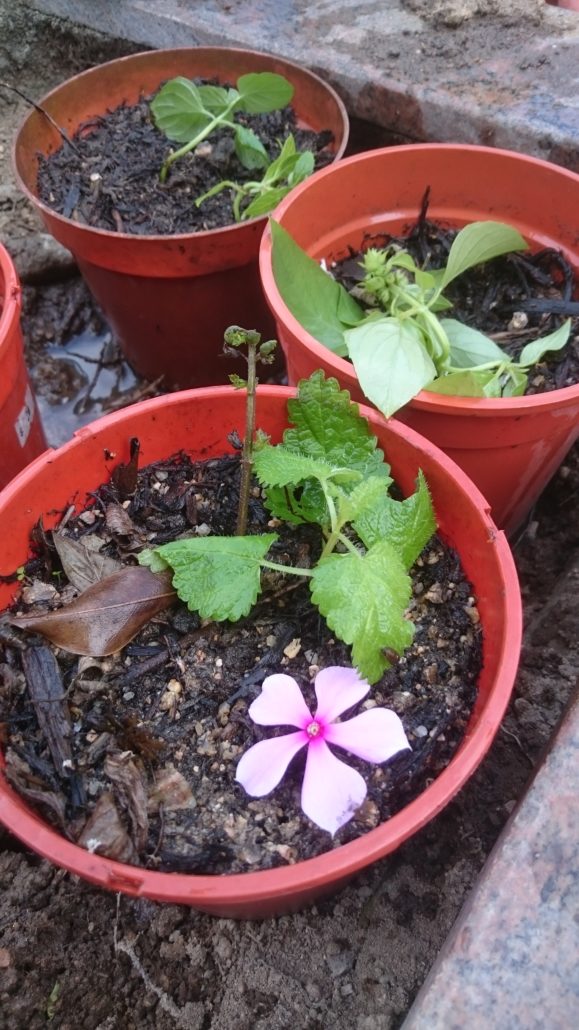
………….
※ We are planning the next step as adding toothbrushing after lunch time!
…………
※ Chinese version will be posted asap when the translation finished!
………….
OK! I stop here.
Thank you for reading a long post!
Have a nice day!
Mabo
Director and Head Teacher of Villaggio Dei Babmini

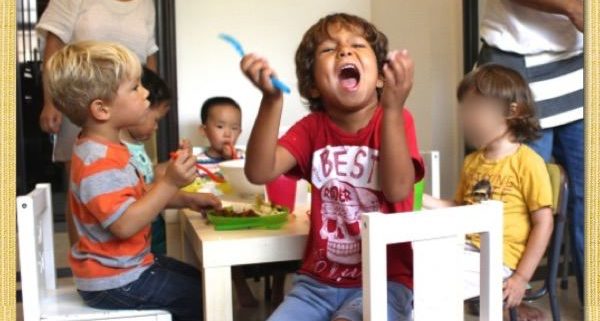

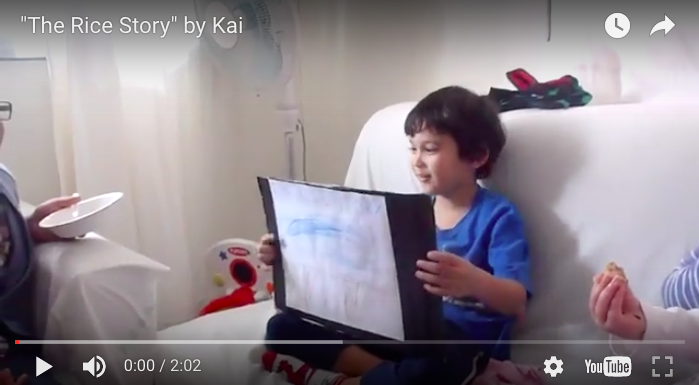


Leave a Reply
Want to join the discussion?Feel free to contribute!